|
Spencer Herbert
The Data Of Ethics;
Williams & Norgate 1907: 1907. Hardcover. Used; Good. No dust jacket. Light wear to extremities. <p><i><strong>Fast Dispatch. Expedited UK Delivery Available. Excellent Customer Service. </strong></i> <br/><br/>Bookbarn International Inventory #2583076</p> Williams & Norgate 1907: hardcover
Referência livreiro : 2583076
|
|
|
Dian Zillner
Dolls and Accessories of the 1930s and 1940s A Schiffer Book for Collectors
Schiffer Pub Ltd 2002. Hard Cover. Very Good. Very nice hardback. No jacket as issued. Light wear. Text is clean unmarked. Shelf location: M5 All items carefully packed to avoid damage from moisture and rough handling. Tracking included. Schiffer Pub Ltd hardcover
Referência livreiro : 058112 ISBN : 0764314521 9780764314520

|
|
|
Cote Richard N.
Mary's World: Love War and Family Ties in Nineteenth-Century Charleston
Mount Pleasant SC: Corinthian Books 2001. Paperback. Very Good. 8vo. 467 pages indexed. SIGNED softcover bound in illustrated covers. Binding is lightly rubbed. Author has signed title page. Text is clean and sound. <br/> <br/> Corinthian Books paperback
Referência livreiro : 032921 ISBN : 1929175043 9781929175048

|
|
|
Lefschetz S
Lectures on Differential Equations
Princeton University Press 1946. Paperback. Used; Good. Ex Library. <p><i><strong>Fast Dispatch. Expedited UK Delivery Available. Excellent Customer Service. </strong></i> <br/><br/>Bookbarn International Inventory #2471049</p> Princeton University Press paperback
Referência livreiro : 2471049
|
|
|
SANNAZARIUS.
Actii Sinceri Sannazarii Neapolitani viri patricii Opera latina omnia & integra. Accedunt notae ad Eclogas Elegias & Epigrammata. Bound with: Trium fratrum Amaltheorum Hieronymi Io. Baptistae Cornelii Carmina. Editio secunda plurimis in locis castigata.
Amsterdam Amstelaedami Apud Henricum Wetstenium 1689. 12mo. 2 volumes in 1: XXIV2382 blank; XII132 p. Vellum. 15 cm Ref: STCN ppn 842282777; Brunet 5127; Graesse 6/1265; Ebert 20262 Details: 5 thongs laced through the joints. 2 titles printed in red and black each with the same woodcut printer's mark on it depicting a celestial sphere. After the preliminary pages of the first volume come Sannazaro's Latin poems p. 1/158 followed by explanatory notes p. 159/238. The second volume contains the Latin poetry of the Amalthei brothers Condition: Vellum age-toned back soiled. Bookplate pasted on the front pastedown. Old ink inscription in English on the verso of the flyleaf at the end Note: We learn from the 'Praefatio' of the 'Opera omnia' edition of Sannazarius Amsterdam 1728 that the editor and commentator of this edition of 1689 is the Dutch scholar Janus Broukhusius. Already on the first page of that 'Praefatio' of the Sannazarius of 1728 which was edited by the Dutch minor poet Pieter Vlaming 1686-1733 the editor tells the reader that he used for his edition the previous edition of Broukhusius published by Wetstein. 'editionem Wetstenianam secutus .' etc. Praefatio 1728 p. 6 recto In addition we read on the title page of 1728: 'ex secundis curis J. Broukhusii'. This proves that the edition of 1689 was published by Janus Broukhusius Joan van Broekhuizen in Dutch 1649-1707. � This scholar/soldier pursued during an adventurous life his classical studies and poetry at leisure. As a neolatin poet he is known as the 'Propertius of Holland'. Sandys 2329 In 1684 he published his 'Carmina' a collection of his Neolatin poetry. His editions of Propertius 1702 and Tibullus 1707 laid the foundation for his reputation as a classical scholar. He was admired as a latinist for his taste and for his erudition. NNBW 4309/12 � The Italian and Neo-latin poet Jacopo Sannazaro 1458 -1530 in Latin Jacobus Sannazarius also known as Actius Sincerus was of noble birth and a courtier at the court of the royal House of Aragon kings of Naples. Here he found a humanist atmosphere favourable for the development of his talents. The humanist Giovanni Gioviano Pontano 1426-1503 advisor and chancellor of the Aragonese dynasty became his intellectual mentor. He took his young student in his Academy the 'Accademia Pontaniana' under the name of 'Actius Sincerus'. There he deeply influenced his pupil's philological approach to antiquity and his knowledge of classical culture. After Pontanus' death Sannazarius became the head of this Academy. Sannazarius' masterwork 'Arcadia' written in Italian exercised a great influence on European poetry instituting the theme of the idyllic land Arcadia. He devoted the last decades of his literary activity exclusively to Neo-Latin poetry modelled on Vergil. In the normative 'Tati Renaissance Library' Sannazarius is advertised as 'the finest Neo-Latin poet of the Italian Renaissance'. His 'corpus' of Latin poetry written in an elegant style was small but nevertheless very influential and widely read. We counted in KVK ca. 30 editions of his 'Opera Omnia' printed before 1689 the first of which was published by Aldus in 1535. His 'De partu Virginis' an epic of ca. 1450 verses published in 1526 brought him the title of the 'Christian Vergil'. His style is said to be equal to Vergil with whom he emulated. In his other works he also emulated with Ovid and Horace. � In the first volume of this edition of 1689 we find Sannazaro's poetry; the collection opens with: 'De partu Virginis libri tres' a poem which Erasmus is said to have liked though he found this poem on the birth of Christ too secular. Follows a short 'Lamentatio de Christi morte' then 5 'Eclogae' which renewed the bucolic genre the traditional shepherds of Virgil being replaced here by fishermen. Follow Sannazarius' 'Elegiarum libri tres' and 3 books of 'Epigrammata'. � The second volume contains the 'Carmina' of the brothers Hieronymus Jo. Baptista and Cornelius Amaltheus Jeronimo born 1507 Giambatista born 1525 and Cornelio Amaltheo edited by the Dutch latinist Johannes Georgius Graevius who was a friend of Broukhusius the editor of the first volume. All 3 brothers were skilled and highly appreciated neo-latin poets. Hieronymus whose style was of singular elegance and purity so excelled in Latin poetry that he is placed by the French humanist Muretus 1526-1585 among the most talented poets. Giambatista's Latin poems gave him a reputation equal to his brother. Cornelius left only a few Latin poems he died young. They show that he shared the talents of his brothers. The poems of the brothers were first collected and published by Hieronymus Alexander at Venice in 1627. Graevius here offers a revised 'editio secunda' Provenance: The armorial bookplate on the pastedown is of 'Henry A. Bright' its motto is 'Post tenebras lucem'. The family pedigree of the English merchant and author Henry Arthur Bright 1830-1884 'goes back to Nathaniel Bright of Worcester 1493-1564 whose grandson Henry Bright was canon of Worcester and purchased the manor of Brockbury in the parish of Colwall Herefordshire which still remained in the family'. He was educated at Rugby School and at Trinity College Cambridge. In Liverpool he was the centre of literary interests and literary friendships. He was a member of the Roxburghe Club and of the Philobiblon Society as well as of the local historical and literary societies. Source Wikipedia 'Henry Arthur Bright' The family had a substantial library put together over generations Collation: 12 A-K12leaf K12 blank; 26 2A-E12 2F6 Photographs on request hardcover
Referência livreiro : 154826
|
|
|
SANNAZARIUS.
Actii Sinceri Sannazarii Patricii Neapolitani Opera omnia latine scripta ex secundis curis J. Broukhusii. Accedunt Gabrielis Altilii Danielis Cereti & fratrum Amaltheorum carmina; vitae Sannazarianae & notae Petri Vlamingii.
Amsterdam Amstelaedami Apud viduam Gerardi onder den Linden 1728. 8vo. IIXVIII errata63220 index & errata p. frontispiece 1 engraved plate 1 text engraving. Green vellum. 20 cm Ref: STCN ppn 189042265; Brunet 5127: 'Bonne �dition'; Graesse 6/1265; Ebert 20263 Details: This book has 2 different title pages. This anomaly tell us about a publisher's death and the efforts of his widow to continue the firm. The very first title bound before the frontispiece is printed in black has no printer's mark and shows the impressum: 'Amstelaedami Apud Gerardum Onder de Linden 1727'. The second title bound after the frontispiece is printed in red and black has a printer's mark but is now dated 1728 and published 'apud Viduam Gerardi Onder de Linden'. Gerard Onder de Linden died in 1727 leaving Vlaming's Opera edition of Sannazarius unfinished. In the 'Boekzaal der geleerde waerelt' volume 25 of december 1727 the public was informed that the widow who hoped to continue the business with the help of God was planning to publish the Sannazarius' edition soon. 'De Weduwe Gerard Onder de Linden die in afwagtinge van Godts hulp met hare winkel enz. in alles zal continueren zal in 't kort uitgeven 'Actii Sinceri Sannazarii . Opera' We couldnot find in the STCN and KVK any copy of Vlaming's edition dated 1727. The title page of 1727 was apparantly removed in most copies. In the mean time the widow had apparantly decided to print a more posh red-and-black title adorned with a printer's mark. She added also a nice frontispiece with her name on it designed and executed by 2 wellknown Dutch artists. She did so in cooperation with the Amsterdam printer Hermannus Uytwerf who brought copies on the market with his own imprint. The rest is identical. � Vellum dyed green. Back with 5 raised bands and a red morocco shield in the second compartment. Edges dyed red. The frontispiece designed by J. Goeree and executed by J. Houbraken depicts a bare-breasted Fama holding in her right hand her trumpet and a shield with the portrait of Sannazarius; on the shield his name: Actius Sincerus Sannazarius; under the left arm of Fame rests a scroll with the table of contents. � Printer's mark on the title depicting Fama flying above symbols of wisdom and blowing her trumpet. The motto is derived from Martial X212 and reads: 'Non norunt haec monumenta mori' 'These monuments donot know how to die'. � Text engraving on page 491 at the beginning of a biography of Sannazarius by Joannes Antonius Vulpius; depicted are both sides of a bronze medallion on the recto the portrait of Sannazarius and on the verso a scene with the birth of Christ referring to Sannazarius' 'De partu Virginis'. At p. 526 has been inserted a full page engraving of the 'Sannazaro Monument' in the church 'Santa Maria de Parto' a church built on the initiative of Sannazarius on a piece of land donated by king Frederick Frederigo of Aragon. The mausoleum erected in 1537 is a highlight of Napolitan Renaissance art. It was probably made after a design by Sannazarius himself Condition: Binding scuffed and worn at the extremes. Head and tail of the spine chafed. Corners bumped & slightly creased. Both joints splitting but strong. An old ink insciption on the 1728 title has been wiped out resulting in some stains. Paper yellowing Note: The Italian and Neo-latin poet Jacopo Sannazaro 1458 -1530 in Latin Jacobus Sannazarius also known as Actius Sincerus was of noble birth and a courtier at the court of the royal House of Aragon kings of Naples. Here he found a humanist atmosphere favourable for the development of his talents. The humanist Giovanni Gioviano Pontano 1426-1503 advisor and chancellor of the Aragonese dynasty became his intellectual mentor. He took his young student in his Academy the 'Accademia Pontaniana' under the name of 'Actius Sincerus'. There he deeply influenced his pupil's philological approach to antiquity and his knowledge of classical culture. After Pontanus' death Sannazarius became the head of this Academy. Sannazarius' masterwork 'Arcadia' written in Italian exercised a great influence on European poetry instituting the theme of the idyllic land Arcadia. After having written the 'Arcadia' in vernacular Sannazarius devoted the last decades of his literary activity exclusively to Neo-Latin poetry modelled on Vergil. In the normative 'Tati Renaissance Library' Sannazarius is advertised as 'the finest Neo-Latin poet of the Italian Renaissance'. His 'corpus' of Latin poetry written in an elegant style was small but nevertheless very influential and widely read. We counted in KVK ca. 30 editions of his 'Opera Omnia' printed before 1730 the first of which was published by Aldus in 1535. His 'De partu Virginis' an epic of ca. 1450 verses published in 1526 brought him the title of the 'Christian Vergil'. His style is said to be equal to Vergil with whom he emulated. In his other works he also emulated with Ovid and Horace. � In this edition of 1728 we find in the first half Sannazaro's poetry; the collection opens with: 'De partu Virginis' a poem which Erasmus is said to have liked though he found this poem on the birth of Christ too secular. Follows a short 'De morte Christi Domini ad mortales lamentatio' then 6 'Eclogae' which renewed the bucolic genre the traditional shepherds of Virgil being replaced here by fishermen. Follow 3 books of Sannazarius' 'Elegiae' and 3 books of 'Epigrammata'. The section on Sannazaro ends with a number of 'Carmina de Sannazario et ad Sannazarium'. The second half of the book contains the short 'Epithalamium' of Gabriel Altilius called 'Sannazarii sodalis' and the even shorter 'Salix' of Daniel Ceretus. The greater part of the second half is filled with the 'Carmina' of the brothers Hieronymus Jo. Baptista and Cornelius Amaltheus Jeronimo born 1507 Giambatista born 1525 and Cornelio Amaltheo together 175 pages edited previously in 1689 by J. Graevius under the title 'Trium fratrum Amaltheorum Carmina'. Graevius' preface is also repeated here. All 3 brothers were skilled and highly appreciated neo-latin poets. Hieronymus so excelled in Latin poetry that he is placed by the French humanist Muretus 1526-1585 among the most talented poets. Giambatista's Latin poems gave him a reputation equal to his brother. After this section follows a biography of Sannazarius written by the Italian classical scholar Giovanni Antonio Volpi 1686-1766 in Latin Johannes Antonius Vulpius. After the biography we find on 54 pages a collection of select 'testimonia' concerning Sannazarius. The book concludes with 50 pages filled with the notes of the Dutch scholar Pieter Vlaming 1686-1733. Vlaming a minor poet had a life long interest in Sannazarius. In 1710 he began with his translation into Dutch of the 'Arcadia' and he later produced the notes in Latin to the present edition of the Latin poems of Sannazaro edited by the Dutch scholar Janus Broukhusius. In the introduction to this 1728 edition written by Vlaming he tells about his interest in Sannazarius: 'ab ineunte aetate imo pene puer unice semper sum admiratus maturiore hac mea veneror suspicio & colo'. p. 6 recto � Vlaming's edition still has great value for the Dutch researcher Corine Flinterman proves in her master paper 'In vergetelheid geraakte epigrammen van Iacopo Sannazaro' Amsterdam 2013 that the latest edition of Sannazaro's Latin works 'Jacopo Sannazaro. Latin Poetry' by Michael C.J. Putnam Cambridge Massachusetts 2009 The I Tatti Renaissance Library 38 suffers from many omissions and mistakes. A sad thing because Putnam's work is considered an authorative point of reference for experts in Renaissance studies. Putnam based his sloppy edition Flinterman reveals on some incomplete 18th century italian editions which lacked 13 anti-papal epigrams. � This title of 1728 seems to be rare for in American Exchange we found only 2 copies both auctioned by Sothebys in 1952 and in 1959 Collation: pi1 title 1727 2pi2 8 minus the leaves 1 & 2 chi1 errata A-2S8 minus the blank leaves 2S7 and 2S8; plate bound after p. 526 The STCN copy doesnot have the 1727 title nor the errata leaf at the end of the preliminaries. This errata leaf is almost identical to the errata leaf at the end Photographs on request hardcover
Referência livreiro : 154825
|
|
|
ENCYCLOPEDIE OU DICTIONNAIRE UNIVERSEL RAISONNE.
Tapis de Turquie. Contenant planches simples 4.
Yverdon 1780. 6 pages 3 plates. Modern plain wrappers. 25 cm Lacking the 4th plate From: 'Encyclop�die ou Dictionnaire universel raisonn� des connoissances humaines' Planches Tome X unknown
Referência livreiro : 154600
|
|
|
CAESAR.
C. Julius Cesars Aantekeningen der Gallische Burgerlyke Alexandrynsche Africaansche en Hispanische oorlogen. Uit het Latyn verduischt door Abraham Bogaert. Met kopere plaaten verciert.
Amsterdam By Nicolaas Ten Hoorn Boekverkoper 1709. 8vo. 2 volumes in 1: XVI341 recte 33926 index3 blank; IV38130 index3 blank p. 12 engraved plates of which 4 folding Vellum 16.5 cm Ref: STCN ppn 177072024; Geerebaert 983; OiN p. 127; Schweiger 255 Details: 5 thongs laced through the joints. Engraved printer's device on the title it depicts a kind of medal with a resting Muse on it; at her feet a wreath an opened book and a lyre; the legend reads: 'Proficit et recreat'; the medal rests on a collection of musical instruments and theatrical objects. The plates are in fine condition. The first plate of volume 1 is a portrait of Caesar below his portrait is the famous murder scene; first plate of volume 2 is a portrait of Pompeius below his portrait the murder of Pompeius Condition: Vellum soiled. Front joint partly split. Tiny hole in the vellum at the outer edge of the upper board. Front hinge cracking but strong. Front flyleaf worn. First 3 gatherings with a faint waterstain. Flyleaf at the end removed Note: Throughout the 17th and 18th century in Europe the Roman historian Julius Caesar 100-44 B.C. remained central to the education of the sons of the elite who trained for public life. He figured as an exemplary military leader. The politician and then tyrant Caesar however was much more controversial in Europe that was torn apart by bloody religious and civil wars. His dictatorship remained problematic though some justified his usurpation of power as the only way out of turmoils of the Roman republic. In the Dutch republic Caesar's most stubborn opponent the senator and patriot Marcus Porcius Cato Uticensis the defender of republican freedom was more appreciated. In the beginning of the 18th century however the mood in the Low Countries was different. The Dutch republic was involved in the War of Spanish Succession 1701-1713 a war between a coalition of several European powers the Dutch republic Britain Prussia and Portugal called the Great Alliance and the kingdoms of France and Spain. France was in that time by far the greatest power in Europe and therefore the Alliance tried to prevent further expansion in the South of Europe and in the America's. In 1708 the French army started an offensive in the Southern part of the Netherlands where the Dutch priority had been to secure their barrier fortress system. The French took Brugge and Ghent by storm. The British army and the forces of the Dutch republic under Marlborough succeeded in defeating the French and to recapture the South of the Low Countries. During this War of Succession the Dutch army reached its greatest expansion 120.000 men. The allied forces finally succeeded in preventing that France and Spain would be governed jointly by the French king Louis XIV. � The dedicatee of this translation of Caesar Commentarii is the 'Raadspensionaris' Prime Minister of the Dutch Republic Antonius Heinsius 'de tong der zeven Staaten / Daar Holland zich mag veilig op verlaaten / In 't midden van den felsten oorlogsgloet / Die Vrankryk nu zal lessen met zyn bloed.' p. 2 recto He will let the French pay with their blood. The translator Abraham Bogaert exhorts Heinsius to take the field once again and follow the example of Caesar. 'Gelust het u ten slagvelde in te tre�n / Te stappen langs een berg van lyken heen / En Cesars tred te volgen daar zyne enkels / In 't bloed staan op der Gallen groove schenkels.' p. 2 verso The French are on the verge of collapse he rymes. 'Wat staaren niet de Gallen op zyn werken op Schildpat Ram en Blyde Wal en Gracht / En grof Geschut en Toorens groot van kracht!' Ibidem idem. Bogaert hopes that the example of Caesar and also his own translation will inspire the 'Raadspensionaris' Heinsius. 'Zo Cesar nu . / Uw doorziende oog in 't Neerduitsch kan bekooren / Dan zal zyn naam met groter luister glooren / Zyn dierbaare asch zich roeren en in 't bloed / Des Bataviers ontsteken eenen moed / Om Lodewyk ten rykstroone uit te klinken'. p. 3 verso In the following introduction Bogaert calls Caesar the 'grootste der Veldheeren' 'Een Held zeker wiens beleid onnavorschelyk wiens dapperheid onnavolgelyk is en die met dezelve kracht van geest heeft gesprooken en geschreeven met welke hij geoorloogt heeft'. p. 4 recto His language and style is exemplary. 'Zyne taale is de zuiverste der Latynen zyne style zacht en teder; en heeft hoe eenvoudig iets edelers dan Tactius met al de pracht zyner woorden'. Idem ibidem A soldier or politician will find in Caesar all he needs 'men vind daar in al 't geene nodig is om volkome Veldheeren en deftige Staatkundigen te maaken'. p. 5 recto Caesar work is a book of hours Getyboek for soldiers. Bogaert used for his translation the edition of Caesar published in 1606 in Leiden by Plantin Raphalengius. p. 6 verso � Abraham Bogaert 1663-1727 was a well known Dutch playwright and poet. He translated also Juvenalis 1693 Suetonius 1699 and Valerius Maximus 1721. NNBW 3131/32 The ancient Roman republic did not seem remote or exotic to Bogaert. Instead it served as an important precedent in politics and history Collation: 8 A-Z8 leaf leaf Z7 verso and leaf Z8 blank Pagination irregular in gathering H: the page numbers 128/129 have been skipped; pi2 A-2B8 2C6 leaf 2C6 verso blank Plates at p. 1 43 folding 191 217 225 259 folding 301; 1 69 75 143 folding 197 folding. The plate that belongs to page 75 of the second volume has erroneously been bound at page 75 of the first volume Photographs on request hardcover
Referência livreiro : 154627
|
|
|
VOSSIUS GJ. G. J.
Latina grammatica ex decreto illustr. DD. Hollandiae West-Frisiaeque Ordinum in usum scholarum adornata; Multis quidem in locis Lud. Lithocomi verbis quibus scholae adsueverant reservatis; sed erroribus quibus scatebat emendatis inutilibus refectis pluribus quae defierent suppletis & omnibus meliori ordine dispositis; studio atque opera Gerardi Joannis Vossii. Editio novissima aliquot in locis castigatior prioribus notis vero longe auctior. Bound with: Latina Syntaxis in usum scholarum Hollandiae & West-Frisiae Superiorum auctoritate adornata; Passim quidem reservatis fere praeceptis & exemplis Ludolffi Lithocomi; Sed plurimus repurgata ab erroribus etiam superfluis omissis additis necessariis atque omnibus meliori ordine digestis opera Gerardi Jo. Vossii qui & uberes notas ad oram adjecit.
Amsterdam Amsterodami Apud Joannem Janssonium 1650. 8vo. 2 volumes in 1: XII176;178 recte 1771 blank p. Vellum 16 cm Details: 5 thongs laced through the joints. First title printed in red & black. Volume two consists of two parts each with its own title. Woodcut printer's mark on all three titles depicting a farmer and a man with a Jacob's staff before his eye between them a celestial sphere above them Fama blowing two trumpets motto: 'Vivitur ingenio' short for 'Vivitur ingenio caetera mortis erunt' 'one lives on by the spirit the rest shall belong to death' Condition: Vellum age-tanned soiled and spotted. Both pastedowns detached. Stamp on front flyleaf. Lower margin very faintly waterstained and warped Note: This Latin grammar was commissioned in 1625 by the Provincal Governments of Holland and West-Frisia Staten van Holland for the use in local Latin schools in the Western part of the Dutch Republic. It was produced by the Dutch classical scholar Gerardus Johannes Vossius 1577-1649 according to Sandys the greatest polyhistor of his age. It is a masterpiece and worthy the already impressive series of works he published. In 1622 Vossius was appointed professor of Eloquence Latin at Leyden and in 1631 he accepted the professorship of History at Amsterdam. His Latin grammar remained the standard grammar on Dutch schools until the middle of the 19th century. � In 1625 the 'Staten van Holland' decreed that the same set of rules should apply to all public schools in their provinces. The schools should have the same order of classes and lessons the same schedule authors and exercises. It was decided that uniform schoolbooks grammars and sound texts were needed. E.J. Kuiper 'De Hollandse 'Schoolordre' van 1625' Groningen 1958 p. 80 The 'Staten of Holland' wanted to improve education at the Latin-schools which prepared for the University for the standard of education and discipline had got worse because of the Eighty Years' War. The Latin grammar was first published in 1626 and found the next 2 centuries numerous new and revised editions. The first volume contains the latina etymologia the second the latina syntaxis the third the latina prosodia Provenance: On the frontpastedown in ink: 'Ex Bibliotheca Scholae Grypeswaldensis' on the recto of the detached pastedown the oval stamp: 'Lehrer-Bibliothek des Gymnasiums zu Greifswald'. Books of this school library were sold in the sixties and seventies of the 20th century by the Zentralantiquariat in Leipzig. � On the front flyleaf a green stamp of 'Univ. Doz. Dr. Mag. F.F. Schwarz Professor. A 8010 Graz Panoramagasse 2A' with a handwritten date of acquisition '1975'. Franz Ferdinand Schwarz was from 1982 till 1996 professor of classical philology at the University of Graz where he was born in 1934. He died in his hometown in 2001 after a long illness. See his wikipedia lemma 'Franz Ferdinand Schwarz' Collation: 6 A-L8; a-k8 l10 minus leaf l10 verso leaf l9 blank Photographs on request hardcover
Referência livreiro : 120192
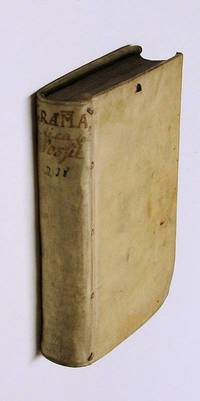
|
|
|
CICERO.
Orationes selectae sex. In usum juventutis edidit notisque instruxit H. WEYTINGH.
Delft Amst. Allart Stumpe 1826. VIII360 p. Vellum 21.5 cm Latin text and notes in Latin; Rosc. Am.; Verr.II4; De lege agraria2; Sull.; Red. in Sen.; Balb.Stamp on title; 6 thongs laced through cover hardcover
Referência livreiro : 107908
|
|
|
EMMIUS U.
Graecorum Respublicae ab Ubbone Emmio descriptae.
Leiden Lugd. Batavorum Ex officina Elzeviriana 1632. 24mo. 2 parts in 1: 4266 index;3237 index & privilegium p. Vellum 11.5 cm Ref: Willems 364; Berghman 1573; Rahir 345; Ebert 6690 Details: 5 thongs laced through the joints. Boards with blind double fillet borders. Title engraved by C.C.Duysend depicting around the text of the title a floral cartouche on top of which rests an eagle aquila with spread wings holding in its talons the deadly thunderbolts fulmina of Jupiter. The eagle was called by Aristotle for the lordly manner with which it looked over the earth 'divine among birds'. HA 619b.6 The eagle is flanked by an owl wisdom and two 'kissing' pigeons. Faint manuscript title on the back. The second part has its own title on it a woodcut printer's mark featuring an old man who stands in the shade of a vine-entwined elmtree symbolising the symbiotic relationship between scholar and publisher. The motto is: 'Non solus' probably indicating the interdependency of publisher and scholar. They cannot do it alone and need each other Condition: Vellum soiled and stained. Occasional old ink underlinings in the first 2 gatherings. A few old ink marginalia. Small stain on the upper margin. Bookplate and small label on the front pastedown. Old inscription on the verso of the front flyleaf Note: Ubbo Emmius 1547-1625 born in Eastern Friesland was appointed professor of History and Greek literature at the newly established University of Groningen in 1614 where he became also the first Rector Magnificus. In his publications and correspondence with eminent scholars of his time he defended the right of a people to revolt an idea that would eventually lead to the French revolution. In the Netherlands he is best known for his Rerum Frisicarum Historia 1592-1616 the first modern study of Friesland and the Frisians in which he refuted many idle tales related by earlier historians of Friesland. Among classicists and ancient historians he is known for his 'Vetus Graecia illustrata' a three volume work which he composed during the last years of his life and which was published posthumously in Leiden in 1626 by the Elzevier brothers. The third volume which describes the particular form of government of every state or commonwealth of Greece was published in 1632 separately by Elsevier as 'Graecorum Respublicae' Provenance: Bookplate without a name on the front pastedown featuring a jumping salmon above which the motto: 'imparibus par'. The label on the front pastedown: 'S.H. Weiss librairie Constantinople grand rue de Pera vis-�-vis le consulat de Russie'. On the front flyleaf a small name: 'Fr. Haug 1832'. This is probably the German historian Karl Friedrich Haug born 1795 died 1869. ADB 11 52/54 'Haug war f�r 30 Jahre Inhaber des Lehrstuhls f�r Universalgeschichte an der Eberhard Karls Universit�t T�bingen'. Wikipedika On the blank lower margin of the title; 'F. Gublingius'. We only found this in a chapter called 'Modernes und Merkw�rdiges im Altertum': 'Ein gewisser Georgius Fridericus Gublingius schrieb im Jahre 1725 eine Dissertation in Wittenberg mit dem Titel: 'De barba Deorum ex priscarum Graeciae et Latii maxime Religionum monumentis'. Behandelte er in dieser gelehrten Schrift die Frage ob die G�tter b�rtig waren so in einer anderen im gleichen Jahre ebenfalls in Wittenberg erschienenen unter dem Titel: 'De causis barbae Deorum' die ebenso wichtige nach den Gr�nden dieser B�rtigkeit'. M. Kemmerich 'Kultur-Kuriosa' Langen 1910 vol. 2 p. 25/26 Collation: A-2D8; A-X8 minus the leaves X7 & X8 the last 2 blank leaves Photographs on request hardcover
Referência livreiro : 120060
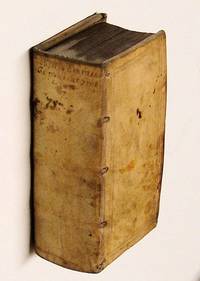
|
|
|
CICERO.
Epistolarum selectarum libri tres in usum scholarum curante C.F. NAGEL qui animadversiones et Belgicam interpretationem vocum & loquendi formularum difficilorum adjecit.
Leiden Honkoop 1802. 16112 p. Vellum 16.5 cm hardcover
Referência livreiro : 107928
|
|
|
Phyllis Bottome
Masks and Faces
Faber And Faber 1940. First published 194. Hardcover. Used; Acceptable. Edition: First published 194. No dust jacket. Previous owners inscription. <p><i><strong>Fast Dispatch. Expedited UK Delivery Available. Excellent Customer Service. </strong></i> <br/><br/>Bookbarn International Inventory #2378579</p> Faber And Faber hardcover
Referência livreiro : 2378579 ISBN : 0571022359 9780571022359
|
|
|
Elizabeth Levett
EUROPE SINCE NAPOLEON
Blackie 1934. Hardcover. Used; Good. No dust jacket. Foxing to page edges. Printed date 1929. Wear to extremities. <p><i><strong>Fast Dispatch. Expedited UK Delivery Available. Excellent Customer Service. </strong></i> <br/><br/>Bookbarn International Inventory #2378545</p> Blackie hardcover
Referência livreiro : 2378545
|
|
|
WMThackeray W. M.
THE VIRGINIANS.
Collins 1859. Hardcover. Used; Acceptable. No dust jacket. Hinges weak. Illustrated Plates. <p><i><strong>Fast Dispatch. Expedited UK Delivery Available. Excellent Customer Service. </strong></i> <br/><br/>Bookbarn International Inventory #2378890</p> Collins hardcover
Referência livreiro : 2378890
|
|
|
VELLEIUS PATERCULUS.
C. Velleii Paterculi quae supersunt. Nicolaus Heinsius Dan. F. recensuit et castigationum libellum addidit.
Amsterdam Amstelodami Ex officina Elzeviriana 1678. 12mo. XXIV11529 index;10812 addenda & index p. engraved title. Vellum 14 cm Prize copy Gouda Ref: Willems 1550: 'Des 5 �ditions de Paterculus donn�es par les Elzevier celle-ci est la plus estim�e. Elle pr�sente un texte nouveau revu par N. Heinsius'; Berghman 2110; Rahir 1686; Schweiger 21128; Brunet 4430: '�dition pr�f�rable'; Fabricius/Ernesti 220; Graesse 5162; Ebert 23478; Prize copy: Spoelder Gouda 2 p. 568 Details: 6 thongs laced through the joints. Back ruled gilt. Boards with double fillet gilt borders. Gilt coat of arms in the centre of the boards. Engraved title it depicts Aeneas with his father Anchises on his shoulders and holding the hand of his son Ascanius; Anchises shows the way he points at the motto: Fata viam invenient a quote from Vergil's Aeneid Book X verse 113; in the background burns Troy. The first part 115 pages contains the text the second part 108 pages the notes of Heinsius Condition: Without the prize. Vellum age-tanned. Gilt fading. Ownership entry on the front pastedown. Inscription on the front flyleaf. Right margin of the title slightly soiled. Occasional pencil stripes in the Latin text Note: The work of the Roman historian Velleius Paterculus ca. 19 BC - after 30 AD commonly called Historia Romana is a valuable source for the reigns of the Roman emperors Augustus and Tiberius. It is the only history written by a witness of their time. Paterculus who served 'under Tiberius in many of his most important campaigns seems to have conceived an unbounded admiration for him and the whole imperial family in whose men he could see nothing but sublime virtues while the enemies were compact of every possible vice'. H.J. Rose 'A handbook of Latin literature London 1967 p. 355 Velleius' adulatory type of history was however condemned by the later historian Tacitus who ignores him. � The Historia Romana consists of 2 books. The beginning of the first is lost from the founding of Rome to the battle of Pydna in 168 BC in which the Romans defeated the Macedonian kingdom. What remains of book one ends with the fall of Carthago in 146 B.C. Book 2 is of greater importance. 'Book 2 covering the period 146 BC to AD 30 becomes more detailed as it approaches the author's own day doubtless because as he tells us he projected a fuller history from the Civil War onwards.' OCD 2nd edition p. 1111/12. Velleius' style is less polished but we are to remember that he was more a soldier than a rhetorician or scholar. Still long time the work of Velleius was considered to be a kind of rhetorical patchwork produced by an opportunistic court historian. However 'erst seit kurzem arbeitet man intensiv an einer Neubewertung des Velleius und seines Oeuvre als eines 'interpretationsf�higen und interpretationsbed�rftigen Textes sui generis'. Neue Pauly 12/1 1170/71 � The Dutch neolatin poet and classical scholar Nicolaas Heinsius 1620-1681 is to be ranked in the opinion of the Dutch Latinist Petrus Burman among the best interpreters of this historian. David Ruhnkenius however who allowed Heinsius 'every praise as an editor of the Latin poets thinks him greatly deficient' in his edition of Velleius. Dibdin The suggestions notes and emendations of Heinsius are frequently discussed in the normative Cambridge edition of Velleius Paterculus of A.J. Woodman who observes that Velleius was certainly not a panegyrist but that modern historians sided with Tacitus and have 'invariably tended to accept the criteria which Tacitus laid down for judging the early empire and its rulers. There is no reason why these should be the only valid criteria. The writing of history is an interpretation of various items of evidence: Velleius' own lifetime coincided with the period which he covers in the Tiberian narrative and it is almost always possible to corroborate from other ancient sources the statements which he makes concerning contemporary events. What objection can there be to an historian who recognised the benefits inherent in the imperial system and who devoted his rhetorical skill to the production of a corresponding interpretation of events'. A.J. Woodman 'Velleius Paterculus the Tiberian narrative' Cambridge 1983. p. 53 Cambridge Classical Texts and Commentaries 25 Provenance: On the front pastedown in a modern hand: 'G. Henderson Essex Court Temple'. Essex Court lies in the Temple an area of central London in the vicinity of Temple Church. Henderson probably a jurist also made the inscription on the front flyleaf. On the front pastedown also an older name: 'Vad: Platii Pigotiani e dono S. fratris 1877'. A mysteryCollation: 12 A-L12 Photographs on request hardcover
Referência livreiro : 120414
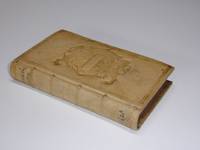
|
|
|
SOPHOCLES.
Trag�dies grecques de Sophocle traduites en fran�ois avec des notes critiques & un examen de chaque piece selon les r�gles du Th�atre. Par Monsieur D'Acier.
Paris Chez Claude Barbin 1693. Small 8vo. Frontispiece X324 p. Vellum 16.5 cm Ref: Hoffmann 3428; Schweiger 1298; Moss 2609; Ebert 21521; Graesse 6/1447; cf. Neue Pauly Suppl. 2 p. 554 for the edition of 1692 Details: 5 thongs laced through the joints.The frontispiece depicts the tragic poet in the background a scene on a stage. Title in red and black. Prose translation of the Oedipus Rex and the Electra. At the end of each play ca. 60 pages filled with 'remarques' Condition: Small inkstain on the frontcover Note: The French scholar Andr� Dacier 1651-1722 was the first Frenchman to translate a Greek tragedy in 120 years! The latest translated tragedy dates from 1573 an 'Antigone' translation of J.-A. de Baif. During this period the Roman author Seneca was the only tragedian in the spotlight. At the end of the 17th century arose a new demand among men of letters for new translations of almost forgotten classical playwrights. The Parisian publisher Barbin brought in 1692 a French translation of the Poetics of Aristotle by Andr� Dacier on the market an obscure and difficult treatise on the Art of Poetry the first philosophical treatise that focuses on literary theory especially of tragedy and that has exerted a tremendous and lasting influence on western literature. In the same year Barbin and Dacier published a French translation of two plays of Sophocles the Oedipus Rex and the Electra as a kind of companion volume to this Poetics translation. This Dacier makes clear right at the beginning of the preface: 'Apr�s avoir expliqu� la Po�tique d'Aristote j'ai cru qu'il 'etoit necessaire de donner une traduction de quelques Tragedies des Grecs afin qu'on p�t voir en m�me tems la r�gle & l'exemple'. leaf 2 recto' The Oedipus Rex and the Electra are perfect works of art rien de plus parfait for the understanding of Aristotle's treatise. The translation of Sophocles's plays was published anonymously as: 'L'�dipe et l'Electre de Sophocle. Trage�dies Grecques. Traduites en Franc�ois avec des remarques'. Our edition of 1693 is a reissue of this edition with a slightly different title now with the name of the translator but remarkably enough omitting the names of the two plays presented. Most reference works only mention the 1692 edition Collation: pi1 frontispiece 6 minus leaf 6; A-N12 O6 Photographs on request hardcover
Referência livreiro : 120022
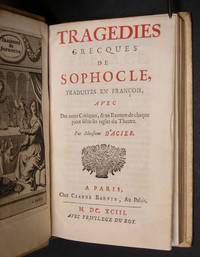
|
|
|
SULPICIUS SEVERUS.
Sulpitii Severi Opera omnia quae extant.
Amsterdam Amstelodami Ex officina Elzeviriana 1656. 12mo. 3333 p. 19th century calf. 13 cm Ref: STCN ppn 852876300; Willems 1207; 1526; Rahir 1233; Brunet 5322; cf. Graesse 6/1376; Ebert 21999; Schoenemann 2391 Details: Nice binding. Back with 4 raised bands. Engraved title depicting Martinus of Tours on horseback ready to cut his cloak in two for a beggar Condition: Binding slightly worn. Bookplate on the front pastedown. Paper slightly yellowing Note: The Latin historian Sulpicius or Sulpitius Severus was born in Aquitania ca. 360 A.D. He organized under the influence of Bishop Martinus of Tours a sort of monastic life on his own estate for himself and his friends. His extant works are a vita S. Martini Turonensis 'which is an apology for ascetism'; and this Sacrae Historiae a kind of universal chronicle to A.D. 402 'which is an important source for the history of 4th-century events . The whole book is an interesting attempt to present a 'breviarium' of history from the Christian point of view: it uses Christian chronographers especially St. Jerome but also Pagan writers. J. Bernays suggested that for the destruction of Jerusalem in A.D 70 Sulpicius followed the lost account of Tacitus. Sallust and Tacitus are his models in the matter of style'. OCD 2nd 3d. p. 983 After the text of the Sacrae Historiae follows the Continuation written by the humanist Johannes Sleidanus 1507-1556 taken from his De quattuor summis imperiis. This treatise of 90 pages deals with the history of the chruch in the Middle Ages until Charles V. After the Continuatio follow three letters on Saint Martin's miracles and death and three dialogues of Sulpicius Severus which compare Saint Martin's feats and virtues with those of the Egyptian hermits. � This Sulpicius edition is a line by line reissue of the Elzevier edition of 1643. Texts of Sulpicius were apparantly in demand for the Elzeviers of Leiden and Amsterdam produced three editions of the Sacrae Historiae 1626 1635 & 1643 and four editions of Sulpicius' Opera 1635 1643 1656 & 1665 Provenance: Armorial bookplate on the front pastedown. Underneath this bookplate a label: 'Ex libris Gulielmi Gaskell Rouse A.M. Ex Aede Christi; Oxon. Anno 1861'. 'William Gaskell Rouse was born c. 1827 in Old Windsor Berkshire. He appears in the 1871 Census aged 44 a Church of England Clergyman living with his wife Gertrude aged 34 in Offley Hertfordshire with three servants. Gertrude was born in St Kitts West Indies and her maiden name was Gertrude Maria Grace Payne daughter of Charles Gillies Payne and Mary Elizabeth Salusbury. William died in 1871'. Rouse studied in Eton and Christ Church Oxford. See the site gaskellfamilycom � The armorial bookplate bears the motto: 'Omne bonum Dei donum' 'Every good is the gift of God'. On the shield are placed in horizontal bars two birds and a rosette. Upon the shield rests a bust of what looks like a bearded Greek philosopher Collation: A-O12 Photographs on request hardcover
Referência livreiro : 120317
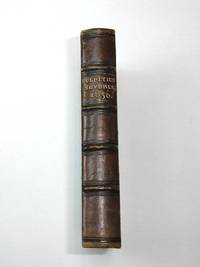
|
|
|
SUETONIUS.
Cajus Suetonius Tranquillus. Van de XII. keizers. Uit het Latijn verduischt door Abraham Bogaert. Met schoone kopere plaaten verciert.
Amsterdam T'Amsteldam By Jan ten Hoorn boekverkoper over het Oude Heeren Logement 1699. 8vo. XX45917 bladwyzer p.; 12 plates. Vellum 17.5 cm Ref: Geerebaert CXXXVI3; OiN 353; Graesse 61 525 Details: Engraved printer's mark on the title showing a table/altar with an overload of symbols of the arts and the sciences in the middle of which rests a big medallion with in its center a resting Kleio the Muse of history; the motto: 'Proficit et recreat'. The plates depict portraits and scenes from the 'Lives'. The STCN Short-Title Catalogue Netherlands calls for a folding table which is lacking in our copy. The digital copy of the Library of Gent doesnot show such a folding plate either Condition: Binding worn and soiled Note: The Roman historian Suetonius born c. 69 A.D is the most influential and best known biographer in the Latin language. He was appointed secretary to the emperor Hadrian a job that gave him access to the imperial records and archive. He made good use of his sources writing the Lives of the XII Caesars or De vita Caesarum. The collection consists of the biographies of 12 emperors from Caesar the founder of the imperial line to Domitian. 'Suetonius like Plutarch believed that a person's character could be revealed in small and insignificant details'. He 'organized his Lives by topics per species rather than chronologically'. The Classical Tradition Cambr. Mass. 2010 p. 912/13 Beyond simplicity and clearness he has no stylistic pretentions. He quotes verbatim from documents he knew and shows critical ability. 'The great number of scurrilous anecdotes in most of the lives may be due to the nature of his sources'. OCD 2nd ed. p. 1020/1 Of another of his works De viris illustribus a collection biographies of famous Roman authors of Lucan Horace Vergil and Terence have survived and his Liber de illustribus grammaticis and his De claribus rhetoribus liber. Suetonius was read in the Middle Ages. The Frank Einhard wrote a biography of Charlemagne along the lines of a Live of Suetonius. From the Renaissance onward Suetonius was neglected until the great edition of 1672 of Graevius. Gibbon praised this Roman historian for his strict dedication to historical truth. � The Dutch author playwright and poet Abraham Bogaert 1663-1727 was chirurgeon for the VOC for which Company he made long voyages to the Dutch East Indies and South Asia. In 1711 he published his Historische reizen door d'oostersche deelen van Asia. He wrote several plays Myrrha Rhadamistus Zenobia which were reprinted many times. He also translated several plays from the French. Bogaert produced also a number of translations of Roman authors Juvenal Amst. 1693 our Suetonius Amst. 1699 reissued Amst. 1728 2nd edition Dordrecht 1735 Caesar Amst. 1709 Valerius Maximus Amst. 1721. His best known historical work is De Roomsche Monarchy vertoont in de muntbeelden der Westersche en Oostersche keizeren Utrecht 1697. NNBW 3131/33 Collation: 8 2 A8-2G8 without the blank leaves 2G7 & 2G8 leaf S4 signed as R4; V3 & Y3 not signed; Y5 signed as Y3; Z2 not signed Photographs on request hardcover
Referência livreiro : 120170
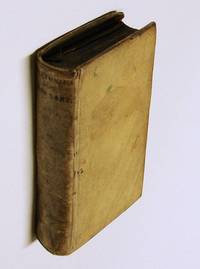
|
|
|
QUINTILIANUS & GEORGIUS TRAPEZUNTIUS.
M. Fabii Quintiliani Rhetoris Clarissimi Oratoriarum Institutionum libri XII restituti pene in universum sibi opera & industria Ioachimi Camer Ioannis Sichardi aliorumque doctissimorum. Adiecta est praecipuorum locorum libri primi & secundi eiusdem Camerarii expositio nec in reliquorum librorum locis difficilioribus quae a doctis annotata sunt aut declarata praeteriimus. Bound with: Isagoge de recto decem praedicamentorum usu inter profitendum Dialectica Trapezontii a Christophoro Hegendorphino in rem studiosorum dictata.
Ad 1: K�ln Apud Coloniam Agripp. In officina Gymnici 1534. Ad 2: Hagenau Haganoae Per Iohannem Secerium 1529. 8vo. Ad 1: XVI7831 blank p. Ad 2: 791 blank p. 16th century calf over wooden boards. 17 cm Two works on rhetoric Ref: Ad 1: VD16 Q 93; Schweiger 2843; cf. Fabricius/Ernesti 2271; Graesse 5528/29; cf. Ebert 18448. Ad 2: Not in VD16! we nevertheless traced a few German copies in KVK Details: Back with three raised bands expertly repaired in antique style. Boards decorated with 2 rows of blind-stamped rolls the first one with portraits the second with floral motives. Ad 1: Woodcut printer's mark on the title it depicts a scepter on which a stork is resting; a hippocampus coiles around the base. Halfway the scepter hangs the motto: Discite iustitiam moniti i.e Be warned learn ye to be just' and not to slight the gods. Vergil Aeneid 6620 Loeb translation At the beginning of each of the 12 books a woodcut initial. Ad. 2: Title with woodcut arabesque borders. Woodcut initials Condition: Boards chafed portraits worn away. Some wear to the joints. Clasps and catches gone. Oval stamp on the first title; Ownership entry on the front pastedown. Three small worm holes in first three gatherings one of them continuing up to p. 350 Note: Ad 1: The Roman orator Marcus Fabius Quintilianus ca. 35 - ca. 100 A.D. was under emperor Vespasian probably the first holder of the chair of Latin rhetoric in Rome paid by the fiscus salarium e fisco accepit Suetonius Vesp. 17-19. His most celebrated work is the 'Institutio Oratoriae' in 12 books. It 'covers the complete training of the orator from the earliest preparation by the grammarian to his most mature aspirations for oratorical preeminence'. The Classical Tradition Cambr. Mass. 2010 p. 827 The ideal was a public speaker who was skilled not only in eloquence but who was also a good man. This is summarized in the famous maxim that an orator is a 'vir bonus dicendi peritus'. Quintilian still makes all that has been written on education from Rousseau to the latest pseudo-psychologist rather worthless. H.J. Rose A handbook of Latin literature London 1967 p. 399 'Book 1 discusses childhood education. . In book 2 the boy enters the school of rhetoric'. In book 3 follows an account of the art of rhetoric 'its origin its parts and its functions. Book 4-6 deal with the detailed structure of a speech . Book 7 is concerned with arrangement dispositio and status-lore. Book 8 discusses style . while in book 9 figures of thought and speech are illustrated'. Book 10 contains a critique of Greek and Latin writers. 'Book 11 discusses memory delivery gesture and dress. The concluding book shows the complete Orator in action a man of highest character and ideals . Roman gravitas at its noblest'. OCD 2nd ed. p. 907 � The 'Institutio Oratoria' of Quintilian was known throughout the Middle Ages especially in the summarizing works of the encyclopedists like Cassiodorus and Isidorus of Sevilla. In 1416 the Italian humanist Poggio Bracciolini discovered in Sankt Gallen a complete text after which Quintilian came 'to exert a deep and lasting influence on rhetorical theory and practice'. The Classical Tradition p. 829 The treatise influenced authors like Erasmus and Vives. The humanist Poliziano lectured on him and Lorenzo Valla preferred him to Cicero. His educational ideas were absorbed by Piccolomini Agricola Erasmus De pueris instituendis and Melanchthon. He was also used by Ben Jonson Discoveries Alexander Pope Essay on criticism Du Bos and Goethe. 'Seine Wirkung geht mit der Verfehmung der Rhetorik im 19. Jh. zur�ck doch bleibt Quintilian eine respektierte Gr�sse bis heute'. Neue Pauly 10719 � The German classical scholar Joachim Camerarius was born in 1500 in Bamberg. He died in Leipzig in 1574. He held classical professorships at N�rnberg T�bingen and Leipzig and was one of the most significant representatives of Renaissance humanism in the Reformation. His interests were diverse and his productivity spectacular. 'His numerous editions of the Classics without attaining the highest rank are characterised by acumen en good taste'. In critical acumen Camerarius 'holds one of the foremost places among the German scholars of the sixteenth century'. J.E. Sandys 'A history of classical scholarship' N.Y. 1964 p. 266/67 Camerarius was also a paedagogue and allthough he stressed the supremacy of Greek literature and paideia to his students the work of Quintilian will have appealed to him for its educational qualities. Long before Comenius he developed an educational system for classical studies to which the Czech could revert. Camerarius edition with notes to the first two books was first published in Hagenau in 1531. Ad 2: George of Trebizond was one of the major intellectual figures of the mid-fifteenth century. This hot-headed Greek emigr� who arrived from Crete in 1416 was emprisoned in 1452 for having threatened Poggio Bracciolini with a drawn sword in the papal chancery. He produced numerous Latin translations from the Greek Aristotle Plato Demosthenes Ptolemaeus and several church-fathers. He followed the original as closely as possible rather than striving for eloquence. His greatest achievement was the introduction of the Byzantine rhetorical tradition to the West. In 1433/34 he published his Rhetoricorum libri quinque which was 'the first work on rhetoric in the Renaissance to make the Latin speaking world aware of the principles of Hermogenean rhetoric with its doctrine of forms and status. It was also the first complete treatment of rhetoric since Quintilian's Institutiones Oratoriae. Trebizond's small Isagoge dialectica written in 1438 and designed as an appendix . was intended to provide the orator with necessary training in logic. Because the Rhetoricorum libri V had already covered the problem of invention with its detailed treatment of loci and formae the Isagoge was concerned primarily with judgment and only to the extent that this was relevant for orators. . While of little lasting importance in Italy the Isagoge had a long life in Northern Europe. As opposed to the Italian humanists those in the North considered invention to be not a part of rhetoric but rather the most important aspect of logic. Source: R.G. Witt George of Trebizond: A Biography and a Study of His Rhetoric and Logic by John Monfasani Speculum Vol. 53 No. 2 Apr. 1978 pp. 406-408 The Isagoge was printed frequently and was also commented upon in this Isagoge de recto decem praedicamentorum usu inter profitendum Dialectica Trapezontii . in rem studiosorum dictata by the German scholar theologian and paedagogue Christoph Hegendorff Latinized as Christophorus Hegendorphinus 1500-1540. In 1523/24 he already was Rector of the University of Leipzig. Later he was sometime professor of law in Frankfurt/Oder and in 1539 he helped to restore the University of Rostock to its former glory Provenance: On the front pastedown: 'Ex Bibliotheca Scholae Grijpeswaldensis'. On the title the stamp: 'Lehrer-Bibliothek des Gymnasiums zu Greifswald'. � In pencil on the front flyleaf: '8 sept. 1964' written by the Flemish linguist Walter Couvreur 1914-1996 who was an Orientalist and professor of Indoeuropean linguistics at the University of Gent. On the pastdown in the rear he has written: 'Leipzig Zentralantiquariat'. It indicates the date and place of acquisition Collation: Ad 1: a-b8; A-Z8 Aa-Zz8 alpha8 beta8 gamma8 leaf gamma8 verso blank. Ad 2: A-E8 leaf E8 verso blank Photographs on request hardcover
Referência livreiro : 120314
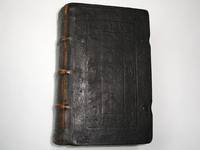
|
|
|
STATIUS.
P. Statii Papinii Opera quae extant Ioh. Bernartius ad libros veteres recensuit & scholiis illustravit. And: Joh. Bernartii Ad Statii Papinii Thebaidos et Achilleidos Scholia Ad Sylvarium libros notae.In quibus & aliorum scriptorum varii loci illustrantur & explicantur
Antwerpen Antverpiae Ex Officina Plantiniana Apud Viduam & Ioannem Moretum 1595. 8vo. 2 volumes in 1: 42921 blank; 15811 blank p. 19th century brown morocco. 18 cm Ref: STCV 7064372; D. Imhof 'Jan Moretus and the Continuation of the Plantin Press A Bibliography of the works published and printed by Jan Moretus I in Antwerp 1589-1610' Leiden Brill 2014 p. 85 B-28; Schweiger 2964; Ebert 21673; Graesse 6/1480; Fabricius/Ernesti 2333 places this title among the 'memorandae editiones' of the 16th century Details: Back with 2 raised bands. Gilt lettering in second compartment. Boards with blind double fillet borders; edges of the boards and the bookblock gilt; gilt inside dentelles. Volume 1 contains the text of Statius's poems volume 2 the scholia and the notes of Bernartius Condition: Wear to the extremes of the binding. Bookplate on the front pastedown. Oval stamp on the title Note: His fluent and highly polished verse brought the Roman poet Publius Papinius Statius ca. A.D. 45-96 to the court of the Roman emperor Domitianus. He is best known for his epic the 'Thebaid' which tells the story of the civil war between the sons of Oedipus Eteocles and Polynices contesting power over the city of Thebes. The 'Achilleid' tells the story of the education of Achilles. Statius' 'Silvae' is a collection of 32 occasional poems addressed to his friends celebrating their marriages etc. In his epic work there are frequent imitations of Vergil in word and thought. 'The various episodes highly coloured and rhetorical though they be are generally successful regarded as separate wholes the descriptive passages striking and the narrative lively'. OCD 2nd e. p. 1011/12 The Thebaid was extraordinary popular during the Middle Ages and the Renaissance. In Dante Statius even ascends to heaven. The 'Thebaid' was used by Boccaccio and Chaucer and there appeared adaptations in Irish French and Italian. Also Statius' 'Silvae' enjoyed a vigorous afterlife and set a standard for the Neolatin poets of the 16th and 17th century. Composing occasional poetry in imitation of Statius was a common pastime among humanist classicists e.g. Heinsius Scriverius Meursius and in England Milton and Ben Jonson. � Johannes Bernartius or in Dutch Jan Bernaerts was a Flemish humanist jurist historian and philologist born in Mechelen in 1568. He studied classics under Lipsius. Besides this Statius edition he produced also a well received edition of 'De consolatione Philosophiae' of Boethius published in 1607 well after his death in 1601. See: dwc.knaw.nl/bernartius-johannes-1568-1601/ � Bernartius consulted for this Statius edition manuscripts owned by J. Lipsius C. Langius the 'Collegium Trilingue' at Leuven and the Saint Laurentius Library at Li�ge. He also used the 'editio princeps' of Venice 1490 and other early editions. Volume 2 'Praefatio p. 8 The STCV calls for an additional gathering L at the end. Our copy ends finis with gathering K. This omission is explained by Bernartius at the beginning of gathering L: he wrote while this title was being printed Dum scholia nostra formulis excuduntur a collection of additional notes which he thought worthwile to share with the lovers of Statius auctuarium quoddam mihi natum . quasi sub acumine ipso styli'. He and Jan Moretus immediately decided to stop the press and add this 'auctuarium'. Volume 2 p. 161 'Lectori' They did so notwithstanding the fact that a lot of copies had already been sold and shipped. Searching in KVK we found indeed that half of the copies held by European libraries has our pagination and donot have the added gathering. Imhof D. 'Jan Moretus and the Continuation of the Plantin Press' B-28 Provenance: Armorial bookplate of L.A. Burd his motto is 'summa peto'. 'Lawrence Arthur Burd 1863-1931 was a British public school teacher expert on the works of Niccol� Machiavelli and a noted philatelist. Burd was educated at Clifton College under Dr. Percival and attended Balliol College Oxford. He received his B.A. in 1885 and his M.A. in 1888'. . 'In 1886 he joined the teaching staff of Repton School where he stayed until he retired in 1923 becoming the Classical Sixth Form master. He stocked almost from scratch the school library there making it one of the best in the country and the Repton library building is still known as The Burd Library. Burd remained an active historical scholar throughout his teaching career. He was a Fellow of the Royal Historical Society and he produced a new edited edition of Machiavelli's Il Principe The Prince 1891 which was highly praised in The English Historical Review. He also wrote the chapter on "Florence and Machiavelli" in Lord Acton's The Cambridge Modern History Volume 1 1902' Burd further excelled in playing the cello cycling and portrait photography. The quotes on this scholar are from Wikipedia s.v. 'Lawrence Burd'. The stamp on the title is of Burd's school the 'Repton School Library'. Repton founded in 1557 is one of the UK's most famous educational institutions numbering Olympians celebrated authors and three former Archbishops of Canterbury among its alumni. The school is still proud of its library Collation: A-Z8 a-d8 leaf d8 verso blank; A-K8 leaf K8 verso blank Photographs on request hardcover
Referência livreiro : 152324
|
|
|
SECTANUS Q. L. SERGARDI.
Q. Sectani Satyrae in Phylodemum. Cum notis variorum.
K�ln Coloniae Apud J. Selliba 1698. 8vo. 16411 blank p. Vellum 15 cm Among the best ever written by a modern Latinist Ref: VD17 14:702097T; Sandys 2281; IJsewijn Companion 164; cf. Willems 2170; Brunet 5256; Graesse 6338; Ebert 20778 Details: This edition of the satyres of Sectanus was issued with 2 different titles; the title most found is: 'Satyrae XIX in Phylodemum cum notis variorum'. The content is exactly the same apart from the title. The title without 'cum notis variorum' seems rare. The publisher probably decided having printed a number of copies that the book would sell better with the addition 'cum notis variorum'. The imprint on the title is according to VD17 probably false; The book was probably printed in Lucca Condition: Vellum soiled. Head of the spine damaged. Both inner hinges strenghened with a strip of brown paper. Front endpapers inscribed and with owner's inscriptions. Name on the title. The blank upper margin of ca. 30 pages has been repaired with a small piece of paper to hide a worm hole which sometimes nibbles at a letter or some letters of the highest line. The blank right upper corner of the last leaves torn off and also repaired with a strip of brown paper. Small wormhole in the lower margin of the last 45 pages sometimes nibbling at a letter Note: The Venetian nobleman Lodovico Sergardi 1660-1726 published in 1696 a 'series of Latin satires against an enemy which were wholly within the tradition of Horace and Juvenal. He even signed himself Quintus Sectanus Quintus the fifth after Lucilius Horace Persius and Juvenal'. G. Highet 'Juvenal the Satirist a study' Oxf. 1962 p. 217 A second edition augmented with 3 satires appeared two years later in 1698. Highet's explanation of the first name of Sergardi's pseudonym Quintus Sectanus seems far fetched. It seems more obvious that Sectanus is derived from 'sectari' to follow pursue. This book is the result of a quarrel between the first members of the newly established 'Academia Arcadum' in Italian 'Accademia degli Arcadi' which was founded in Rome in 1690. The quarrel was between Sergardi and the lawyer and cofounder of the Academia Gianvincenzo Gravina.The aim of the members was to rescue Italian literature from manierism and to return to simplicity and the beauty of classic poetry. 'Among the Latin poems written by its members one finds both very good work and the deadliest dullness. Lodovico Sergardi/Q. Sectanus' satires . are rightly considered to be among the best ever written by a modern Latinist'. IJsewijn 'Companion to Neo-Latin studies' vol. 1 Leuven 1990 p. 64 Provenance: On the title: 'Ex libris Dom. Xavier'. On the front flyleaf an inscription: 'Ex libris valde Honorabii sic! Domini Joannis Frere Angli quem ille dignatus est in donum accipere ab addictissimo suo Comite Xaverio Marchese Melitensi anno salutis 1824'. This book was a gift of Count Saverio Marchese 1757-1833 who enjoyed great respect as a connoisseur of Maltese culture. His expertise extended over a number of fields among them poetry history archaeology the Maltese language and especially the arts and local art history. After the French had lost Malta to Great Britain in 1800 Malta was made a British Dominion. Marchese 'adapted effortlessly into the British environment under the new government. In 1823 he was elected to the University Committee responsible for examining the University�s performance and progress. In his collection of poems there are a number of sonnets praising British Governors . Marchese was also favourable of British preferences in art and architecture. . His talents and social merits were appreciated by both the Grand Masters and the British Governors who elected him to high social positions and invited him personally to important events and celebrations at the Palace on numerous occasions'. Krystle Farrugia. 'Count Saverio Marchese A Conoscente with Special Reference to His Commentary on Uomini Illustri di Malta'. In this online article is included a specimen of his handwriting which matches the inscription in this book. Marchese wrote on the verso of the flyleaf a short summary of the book. � This book was given by the count to the English author and retired diplomat John Frere Hookham 1769-1846 who served as ambassador in Spain and Prussia. In 1820 on account of the failing health of his wife 'he went with her to Malta where he lived for the rest of his life. In retirement he devoted himself to literature studied his favourite Greek authors and taught himself Hebrew and Maltese. He welcomed English guests was popular with his Maltese neighbours and befriended Mikiel Anton Vassalli the first Professor of Maltese at the University of Malta'. Quote from Wikipedia s.v. John Hookham Frere � This book was at some time brought to Great Britain. Three English owner's entries have been inscribed on the front pastedown. 1 'Fredk York Powell1898'. The English historian Frederick York Powell 1850-1904 wrote articles for the Dictionary of National Biography and the Encyclopedia Britannica and some books on folklore. See Wikisource with his portrait 2 'Arthur Quiller Couch' 1919'. 'Sir Arthur Thomas Quiller-Couch 1863-1944 was a British writer who published under the pen name of Q. Although a prolific novelist he is primarily remembered for the monumental Oxford Book Of English Verse 1250-1900 later extended to 1918 and for his literary criticism. He guided the taste of many who never met him including American writer Helene Hanff author of '84 Charing Cross Road'. See Quiller's lemma in Wikipedia. 3 'Giles Dugdale to Patrick Duff 1945'. Giles Dugdale was an English local historian. His admiration of the Dorset dialect poet William Barnes resulted in a biography of Barnes published in 1953. Dugdale�s other interests included art architecture and archaeology and he was an important member of the Dorset Natural History and Archaeological Society. His portrait can be found on the Wordpress site of the Dorset County Museum. Dugdale gave this copy of 'Sectani Satyrae' to Patrick Duff; he also dedicated his biography of Barnes to the same Patrick Duff. This is probably Sir Charles Patrick Duff 1889-1972 knight and public servant who served as an officer during the First World War later he was private secretary to Prime Minister Stanley Baldwin Collation: A-K8 chi4 minus blank leaf chi4 Photographs on request hardcover
Referência livreiro : 120160
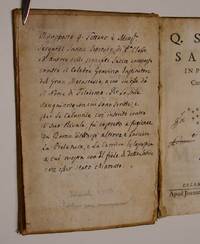
|
|
|
TERENTIUS.
Pub. Terentii Comoediae sex. Ex recensione Heinsiana.
Leiden Lugd. Batavorum Ex officina Elzeviriana 1635. 12mo. XLVIII3048 index p. engraved title. Calf. 12 cm An excellent edition an attractive binding tasteful typography Ref: Willems 433; Rahir 425; Berghman 2151; Schweiger 21065; Dibdin 2472/73; Moss 2671/72: 'one of the most beautiful'; Brunet 5715/16; Graesse 6/159; Ebert 22507 Details: Nice binding. Back ruled blind and with 4 raised bands. Boards with blind double and triple fillet borders and fleurettes. All three edges of the boards gilt. Edges of the bookblock dyed red. Title engraved by Cornelis Cl. Duysend it depicts the Roman general Scipio Africanus in armour while putting the pilleus a felt hat which was given to a slave at his enfranchisement as a sign of freedom on the head of a half naked woman called 'Venus Afra' at her feet sits Amor. Since Terentius mentions Venus only once and incidentally and Scipio didnot manumit the Carthagian Terentius this scene must refer to the liberation of the African Muse in the figure of Venus and hence the freeing of the Muse of the African Terentius by the conqueror of Hannibal and Carthage Scipio Africanus. Woodcut portrait of Terence on p. 8 verso. The Elsevier brothers printed according to Willems 5 issues of this edition in 1635. This is the first and best one. 'La plus belle et la plus estim�e est incontestablement la premi�re qui est un chef-d'oeuvre typographique'. The two Elsevier brothers with the same refugee background as Heinsius gradually brought their typographical artistry to a peak and their production of this Terence edition of 1635 was the first of a series of technical masterpieces. P.R. Selin 'Daniel Heinsius and Stuart England' Leiden/London 1968 p. 10 Condition: Some slight wear to the extremes. An old paper label on lowest compartment of the back. Backstrip slightly beginning to give way at the joint between the head of the spine and the lower board Note: The late antique grammarian Aelius Donatus 4th century A.D wrote not only a commentary on the plays of the Roman playwright Publius Terentius Afer ca. 190-159 B.C. but also a short biography in which he tells that Terentius was born in the Roman province Africa and that he came as a slave in the houshold of the senator Terentius Lucanus. He adopted his name when he was manumitted. Terentius is the author of 'fabulae palliatae' which means 'plays in Greek cloths'. He adapted Greek plays especially those of the Greek playwright Menander to the taste of the Romans. Six of his comedies have survived. For later generations he became a model for elegant Latin. His style was closer to everyday conversation than Plautus' an earlier contemporary comic playwright whose style was more extravagant. He was quoted by Cicero Horace Persius and the Church Fathers. � Ever since antiquity Terentius lived also a long and influential life in schools as a model for Latin language and rhetoric. In the Middle Ages he was read for his moral sentences. He was imitated by the German abbess Hrotsvitha of Gandersheim ca. 935 - ca. 973 in her 'Dramenbuch' with which she wanted to create a Christian alternative for the pagan comedies. With the coming of humanism Terentius enjoyed a renaissance in the classroom and on stage. Scholars rejected the 'barbaries' of Medieval Latin and chose the elegance of Cicero and Terentius as their model. In his 'De ratione studii' 1511 the Dutch humanist Desiderius Erasmus 1466-1536 encouraged the study of Terentius for his language and moral utility. 'Among Latin writers who is more valuable as a standard of language than Terence He is pure concise and closer to everyday speech and by the very nature of his subject matter is also congenial to youth'. The Classical Tradition 2010 p. 930 Erasmus published later in life in 1532 an edition of Terentius' plays. Erasmus seems to have learned the whole of Terentius by heart in his youth. He admired the author for his 'latinitas' and his civilized humor. His ideal as a humanist and pedagogue was the creation of better men with the help of the classics. He held the opinion that schoolboys should read Terentius over and over again. Thus they could master a pure Latin style and learn at the same time good morals. � The Dutch classical scholar of Flemish origin Daniel Heinsius 1580-1655 who enjoyed international fame as an editor of more than 20 classical texts theorist of literary criticism historian and neolatin poet was professor of Poetics at the University of Leiden since 1603 extraordinarius Greek since 1605. After the death of J. Scaliger to whose inner circle he belonged he held the chair of Greek from 1609 till 1647. His Terentius edition first published Amsterdam 1618 saw 15 reissues during his lifetime. Terentius whose comedies were considered useful for a moral education was according to Heinsius the best classical dramatist in conveying appropriately comic characters. 'Longe autem omnibus palmam hac in parte Terentius praeripuit. . Qui prae reliiquis scriptoribus decorum intellexit'. D. Heinsius 'De Tragoediae constitutione' 1611 p. 163 The text of Terence is preceded by Heinsius' famous treatise 'Ad Horatii de Plauto & Terentio judicium dissertatio' first published in 1618 Collation: 8 212 34; A-N12 Photographs on request hardcover
Referência livreiro : 120319
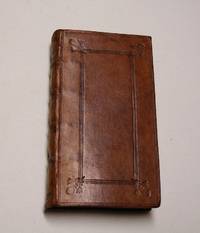
|
|
|
RUTILIUS LUPUS.
P. Rutilii Lupi De figuris sententiarum et elocutionis libri duo. Recensuit et annotationes adjecit David Ruhnkenius. Accedunt Aquilae Romani et Julii Rufiniani de eodem argumento liber.
Leiden Lugdini Batavorum Apud Samuelem et Joannem Luchtmans 1768. 8vo. C27615 index1 blank p. Calf 20 cm Ref: STCN ppn 238551075; Schweiger 2859: 'Neue Recension. . Vorauf geht eine gehaltreiche historia critica oratorum graecorum'; Ebert 19633; Graesse 6/1196; Spoelder p. 590 Haarlem 3 Details: Prize copy without the prize. Back divided with gilt fillets. Red shield on the 'second compartment'. Boards with gilt borders and gilt coat of arms of Haarlem. This title book contains after the preface in which Ruhnken has collected everything known with regard to Rutilius Lupus an informative 'Historia critica oratorum graecorum' of 65 p. The commentary of Ruhnken to the text is extensive Condition: Prize gone. Binding slightly scuffed. Right edge of red shield damaged. Surface of the upper board somewhat chafed; all 4 green textile fastening ties gone. Faint and small stamp on the title Note: 'De figuris sententiarum et elocutionis' On the figures of speech a rhetorical treatise of the Roman rhetor Publius Rutilius Lupus first century A.D. is originally an abridgment of 'peri sch�mat�n' a work of the Greek orator Gorgias of Athens who must not be confused with the famous Gorgias of Leontini the contemporary of Socrates. This Gorgias of Athens is also known as the rhetor who taught Cicero's son Marcus at Athens in 44 B.C. Cic. Fam. 16216 The chief value of the treatise lies in the numerous renderings of abstracts and translations of striking passages from the Greek orators thus preserving much what is otherwise lost. Already in the 'editio princeps' of 1519 it was printed together with 'De figuris' of Aquila Romanus. The first half of this 1768 edition of Ruhnken contains the text of Rutilius Lupus the second half the 'De figuris sententiarum et elocutionis liber' of the Latin grammarian Aquila Romanus who flourished in the second half of the 3rd century A.D. He recommends Demosthenes and Cicero as models but he takes his examples almost exclusively from Cicero. The dates of the Latin rhetorician Julius Rufinianus are uncertain. He produced a kind of supplementary treatise augmented with material from other sources. Both took their material from a lost work of the Greek rhetorican Alexander Numenius 2nd cent. B.C. These 3 works were edited with commentary by the Dutch scholar of German origin David Ruhnkenius or David Ruhnken 1723-1798. In 1757 he was appointed at the University of Leyden to assist professor Tiberius Hemsterhuis as Reader in Greek and in 1761 he succeeded to the Latin chair vacated by Oudendorp. The great classical scholar U. von Wilamowitz-Moellendorff 1848-1931 calls him the 'Princeps criticorum'. The German scholar F.A. Wolf 1758-1824 dedicated his famous 'Prolegomena' of 1795 to him. 'Alles was Ruhnken ver�ffentlicht hat ist in seinen Grenzen tadellos. So der homerische Demeterhymnus . das Lexicon des Timaeus Rutilius Lupus mit einer Historia critica oratorum Graecorum die f�r die hellenistische Zeit n�tzliche Notizen zusammentr�gt'. U. von Wilamowitz-Moellendorff 'Geschichte der Philologie' Leipzig/Berlin 1921 p.39/40 Provenance: The stamp on the title: 'J.S. van Veen'. This is the Dutch historian Jacobus Simon van Veen 1858-1934. See for a biographic sketch and a portrait: C.C. van der Woude 'Dr. Jacobus Simon van Veen 12 januari 1858 - 11 oktober 1934' in 'Honderd jaar Gelre' Hilversum 1997 p. 101/107 Collation: -68 72; A-S8 T2 leaf T2 verso blank Photographs on request hardcover
Referência livreiro : 151897
|
|
|
SECUNDUS JANUS.
Ioannis Secundi opera. Accurate recognita ex Museo P. Scriverii. Editio tertia.
Leiden Lugduni Batavorum Apud Franciscum Moyaert 1651. 12mo. XXVIII366 recte 368 p. Overlapping vellum 13.5 cm Ref: Willems 1669; Graesse 6/1339 Details: Five thongs laced through the joints. Engraved title: two amores looking up at a medal with a portrait of Julia the first love of Janus Secundus; the legend reads: 'Vatis amatoris Iulia sculpta manu' i.e. a portrait sculped by the hand of the author; leaf 8 bears the engraved portrait of Janus Secundus himself holding in his hand a medal with the portrait of Julia; underneath the portrait a 4 line poem by his brother Hadrianus Marius Condition: Very small pear-shape hole 8x5 mm near the head of the spine. Front flyleaf gone; nevertheless a handsome copy Note: The Dutch neolatin poet Janus Secundus Nicolai Hagiensis was born on the 15th of november 1511 the day of the martyr Secundus in The Hague. He died very young in 1536. In 1528 he moved to Mechelen where his father was appointed president of the High Council. This town was the residence of the Austrian vicequeen Margaretha of Parma. The southern part of the Netherlands was in this time the center of a florishing urban civilization. In May 1530 Secundus met a young prostitute from Mechelen called Julia and fell in love with her. Julia became the subject of his first book of elegies his Julia Monobiblos in which he tells how he won and lost his love. During his studies in Bourges under the famous jurist Alciati he wrote his first Basia. Alciati introduced Secundus also to the newest Italian poetry. A humanist poet often started his career with erotic poetry like Piccolomini and Beza. Secundus' kiss-poems are a variation on two kiss-poems of the Latin poet Catullus ca. 84-54 B.C who became during the Renaissance a model for love-poetry. Secundus wrote in his short live 6835 lines of poetry of which only 425 lines were printed during his lifetime. He wrote 'with equal fluency all kinds of lyrical heroic and elegiac verse. Down to the present day Secundus lives in literary history as the kissing poet' . 'Until far in the 18th century Secundus is mentioned as one of the classics of love poetry' IJsewijn Companion to Neo-Latin studies I Leuven 1990 p. 152 The first edition of his collected works was posthumously published in 1541 in Utrecht and was edited by Secundus brother Marius. All later editions are based on this edition. The manuscript with the collected works used for this edition came later in the possession of the Dutch classicist Petrus Scriverius 1576-1660. He produced a new edition in 1612 in which he also incorporated poems of Secundus which had been omitted in the 1541 edition because they were thought to be disagreeable to the French and English king. In his second edition of 1631 Scriverius incorporated more material from other sources and manuscripts. According to Willems is the third edition of 1651 a repetition of the second of 1631. Best source for Secundus is J.P. Gu�pin De kunst van Janus Secundus Amst. 1991. It opens with 20 page with testimonia and iudicia on Secundus. At the end are added some letters and a treatise on the family of Secundus De gente Nicolaia Collation: 12 22; A-P12 Q4 The pagination in gathering F falls on leaf F12 numbered 144/142 back from 144 to 142 the recto of G1 is numbered 143/144 Photographs on request hardcover
Referência livreiro : 120405

|
|
|
THEODORETUS CYRRHENSIS.
Theodoreti Opera Omnia graece et latine ex recensione Iac. Sirmondi denuo edidit Graeca e codd. locupletavit editiones antiquiores adhibuit versionem latinam recognovit et varias lectiones adiecit Io. Ludou. Schulze. Tomos II. Title completely in Greek
Halle En Chal�i t�i Magdebourgik�i En t�i Tupographei�i tou Orphanotropheiou Halae Sax. 1770. 8vo. 2 volumes: XXIV16942 blank p. Half calf. 22 cm 'Biblical exegesis' Ref: Hofmann 3494; Graesse 6/2118; Ebert 22796; Brunet 5786; not yet in VD18 Details: Backs with 5 raised bands. Marbled boards. Greek text and Latin translation in 2 columns. Volume two of five Condition: Bindings scuffed backs skilfully repaired and rubbed. One of the shields on the back of the first volume has gone. Corners bumped boards chafed. Paper foxed and yellowing. Lacking the volume 1 and 3/5 Note: Theodoretus 393-466 A.D. is one of the most successful writers of the Eastern Church. He was 'from 423 bishop of Cyrrhus Syria. From 428 he was involved in the Christological controversy between his friend Nestorius and Cyrill of Alexandria. He became Cyrill's leading critic. Deposed by the monophysite Council of Ephesus 449 he was rehabilitated at Chalcedon in spite of strenuous protests 451 but his attacks on Cyrill received posthumous condemnation under Justinian at the Council of Constantinople 553. His well-composed letters written in elegant prose are informative about both secular and ecclesiastical matters. His 'Graecarum Affectionum Curatio' is painstaking and thorough in contrasting Christianity and paganism. His 'Church History' from Constantine to 428 contains many invaluable documents. The 'Religious History' contains biographies of ascetics. The rest of his work is biblical exegesis and theological controversy both of which he conducted well'. OCD 2nd edition p. 1055 � Theodoretus' exegetical commentaries are according to Quasten among the finest specimens of the Antiochene School and remarkable for their combination of terseness and lucidity. In his interpretation of Holy Scripture Theodoretus adopts a middle course avoiding the radicalism of Theodore of Mopsuestia and his excessive literalness and allowing an allegorical and typological explanation whenever this appears preferable. Quasten 3539 � Theodoretus' 'Opera Omnia' was produced by the German scholars J.L. Schulze and J.A. Noesselt and reprinted in J.P. Migne 'Patrologia Graeca' volumes 80-84. The contents of this second volume was reprinted in volume 81 1864 of the 'Patrologia Graeca'. � This second volume contains: 'Explanatio in Canticum Canticorum; Succincta in Esaiam Prophetam interpretatio; In divini Jeremiae prophetiam interpretatio; Liber XI Baruch; Liber II Lamentationes Jeremiae; In divini Ezechielis prophetiam interpretatio; Commentarius in visiones Danielis Prophetae; Commentarius in Duodecim Prophetas; Enarratio in Hoseam Prophetam; Interpretatio Ioelis Prophetae; Commentarius in Amosum Prophetam; Interpretatio Abdiae Prophetae; Interpretatio Ionae Prophetae; Interpretatio Michaeae Prophetae; Interpretatio Nahumi Prophetae; Interpretatio Prophetae Habacuc; Interpretatio Sophoniae Prophetae; Interpretatio Aggaei Prophetae; Interpretatio Zachariae Prophetae; Interpretatio Malachiae Prophetae' Provenance: Small label on the front pastedown: 'Sold by William Brown130 Old Street London. Libraries purchased'. Brown specialized in Theology. In 'The Ecclesiastical gazette or Monthly register of the affairs of the Church of England' vol. VII June 1845 p. 280 we found an advertisement of him for a catalogue of books relating to 'Ecclesiastical History the Roman Catholic controversy' and a catalogue 'Foreign theological ecclesiastical and biblical literature' Collation: 8 b4; A-5O8 chi 1 after 2T6 = half title of volume 2; leaf 5O8 the last leaf is blank Photographs on request hardcover
Referência livreiro : 153707
|
|
|
SOPHOCLES.
SOPHOKL�S. Sophoclis Tragoediae VII. Ex adverso respondet latina interpretatio in qua verbum verbo reddidit Vitus Winsemius VVinsemius. Carminum ratio ex Gul. Cantero diligenter observata additis eius in totum Sophoclem notis.
Heidelberg Heidelbergae Apud Hieronymum Commelinum 1597. 8vo. 16 p. p. 3-56-701 recte 6991 blank Half vellum. 16.5 cm. 'Canter opened a new era of the tragic poets of Greece' Ref: VD16 S 7039; Hoffmann 3415: 'In dieser Ausgabe Canters fehlen dessen Bemerkungen'; Moss 2598; Graesse 6440; Ebert 21463 Details: 2 thongs laced through the joints. Woodcut printer's mark on the title depicting a woman the naked truth seated on a cubus and holding a radiant sun in her right hand; in her left hand she holds an opened book and a palm leaf; her feet rest on the globe; the garland of fruit which surrounds her shows a ribbon with the text in Greek: 'Al�theia Pandamat�r' Allmighty Truth. Woodcut initials. Greek text with opposing Latin translation. The notes of Canter promised on the title were not printed Condition: Binding scuffed. Remnants of a brown morocco shield on the back. Endpapers renewed probably in the 19th century. The title is thumbed & soiled and shows a faint stamp. The printer's mark is browned/soiled by a paper label which once was pasted on it. Some faint and small waterstains round this printer's mark. Right lower corner faintly waterstained. Some old annotations Note: The study of metrics started already in the time of the Sophists. Herodotus knew iambic trimeters and hexameters. Later the Peripatetici and the Alexandrians developed the technical vocabulary and methods to analyse the metrical structure of lyric parts of Greek tragedies and comedies. What we know of ancient metrics was handed down to us by late antique and byzantine grammarians and commentators especially by the Alexandrian scholar Hephaestion second century A.D. whose 'Enchiridion' summarizes ancient knowledge and offers examples from works now lost. With the help of Hephaestion's handbook the Dutch scholar Willem Canter latinized as Guilielmus Canterus 1542-1575 rediscovered the metrical responsion in the lyrical parts of the plays and was able to correct the corrupted text using metrical responsion. � The 'editio princeps' of the plays of the Greek tragedian Sophocles 496-406 B.C. was produced by the Venetian printer/scholar Aldus Manutius in 1502. The early humanist editors however often corrupted the text which they wanted to correct because they misunderstood the metrics ratio carminum of Greek poetry. They more or less had printed the lyrical parts haphazardly. Canter was aware of this problem. He spent the major part of his short life specializing in Greek tragedy and did work of fundamental importance on the tragedians. He published what may be called the first modern editions of the tragedies of Euripides 1571 Sophocles 1579 and Aeschylus 1580. His editions look more or less like the editions as we know them today. Canter had made visible the outer structure of the lyrical parts. 'The metrical responsions between strophe and antistrophe are clearly marked by means of Arabic numerals in the margin and the text repeatedly corrected under the guidance of these responsions'. J.E. Sandys 'A History of Classical Scholarship' N.Y. 1964 vol. 2 216/17 In his preface to his Euripides edition of 1571 Canter proudly declared that there is no Greek author who's text was better restored in its original glory than the text of Euripides. He has done so by using his genius ingeniolo and by attentively reading the poet. He had some help from work on Euripides done by earlier scholars but they however didnot know anything about metrics he complains. His own knowledge of the metrical structure of tragedies however has helped him often Canter continues to emend quite a number of corrupt passages and fill in lacunae. He has he boasts for the first time brought to light the metrical structure in Euripides' lyrics which had hitherto lain in darkness. This knowledge he says made it possible to understand the poet correctly recte and to correct mistakes. Greek grammatici who write about metrics often make an obscure text even more obscure obscuriorem he complains. Canter calls Sophocles also a victim of this wrong approach and Aeschylus even more so multo magis. That is why he promissed in this preface of 1571 to do the same for them as he did for Euripides. The most important help maximum adiumentum he received from the Greek grammarian Hephaestion. Canter confesses that he simply applied the metrical observations of Hephaestion to Euripides. In the preface to the Sophocles edition Canter acknowledges that the work of the byzantine scholar Triclinius ca. 1300 was of great help concerning this poet because he almost always reconstructed the right metrical structure. fere semper vera carminum est ratio a Triclinio tradita And where Triclinius let him down Canter corrected the text with the help of his own observations and the instructions of the ancient grammarians. Canter's groundbreaking editions of Aeschylus and Sophocles were already completed in 1570 but only published after his death by Plantin. Nobody knows why it took Plantin 10 years to print both books. Nevertheless Canter's edition of Sophocles remained a standard in common use for more than two centuries. � The publisher Commelinus chose the Latin translation of Sophocles of the German classicist Vitus Winsemius 1501-1570 or Veit Winsheim to accompany the Greek text of Canter. This translation was first published in Frankfurt in 1546. As a young man Winsemius went to Wittenberg to study and soon caught the attention of Melanchthon and Luther. He was given financial support by his hometown with a grant of 20 gold guilders a year. His appointment to professor of Greek at his university followed in 1541 later he became professor of Medecine too. In 1538 Winsemius' teacher and close friend Melanchthon who praised him for his knowledge and modesty asked him to publish a new revised edition of his Latin Syntax. Winsemius composed a funeral oration on Melanchthon which is of great biographic value. Winsemius later produced mediocre according to Bursian translations of several Greek authors. ADB 43 p. 462/3 also Eckstein p. 621. Winsemius' Latin translation of Sophocles was repeated in 1549. It reappeared in bilingual editions published in Geneva 1603 Cambridge 1669 & 1673 and London 1722 Provenance: Stamp on the title: 'AD. US. STUD./ PROV. NEERL. S.J./ LITT. CLASS'. We could not locate this stamp of a library for the use of students of the Jesuit Order in the Netherlands. � On the blank lower margin of page 3 in ink: 'Joh. Theod. Freyn constat 12 9 gr.' Collation: 8 A8 B8 minus leaf B8 C-2Y8 2X8 leaf 2X7 verso blank leaf 2X8 blank The 2 other copies we inspected have the same irregular pagination in gathering A and the same collation in gathering B. Nothing is missing between gathering B and C; the text and the pagination progresses regularly on this spot Photographs on request hardcover
Referência livreiro : 120163
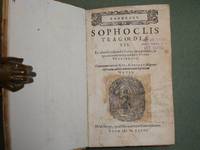
|
|
|
TACITUS.
C. Cornelii Taciti Opera quae exstant. Ad exemplar quod I. Lipsius quintum recensuit. Seorsum excusi commentarii eiusdem Lipsii meliores plenioresque cum curis secundis & auctariolo non ante adiecto. Guil. Barclayus praemetia quaedam ex vita Agricolae libavit. Adiecti sunt indices aliquanto ditiores.
Paris Parisiis Apud Ioannem Gesselin 1599. 8vo. XVI7902 blank24 index p. Overlapping vellum 18.5 cm Ref: Schweiger 21000; Dibdin 2450/2; Ebert 22148; Graesse 6/28 Details: This is the first part of a two volume edition of Tacitus; it contains the Latin text of Tacitus only and lacks the commentary part. Vellum thong laced through joints at the head and tail of the spine; 4 thongs partly gone. Short title in ink on the back. Woodcut printer's mark on the title: depicting the winged mythological horse Pegasus though cloven-hoofed the motto in an oval reads: 'Sic aetas non retinenda fugit' Condition: Vellum age-tanned. Outer edges of the overlapping vellum partly damaged. Book-block almost loose in the binding. Front flyleaf with folds. Title slightly soiled and thumbed. Small and faint waterstain at the right lower corner of the first 5 leaves Note: The Flemish latinist Justus Lipsius 1547-1606 was invited in 1579 to come to Leiden to the recently founded university as a Honorary Professor of History. At that date he already had produced his great Tacitus-edition published by Plantin a work that placed and still places him in the front rank of classical scholarship Antwerp 1574. His main strength lay in textual criticsm and in exegesis. His emendations are considered to be very clever and his commentary rich. Plantin published a second edition in 1581 with new emendations and 'variae lectiones'. Lipsius's third edition Antwerp 1585 offered a new recension. The fourth edition was published by the son in law of Plantin Franciscus Raphelengius in Leiden in 1588. Lipsius remained there for 11 years a period of his greatest productivity. Plantin in Antwerp published again in 1588 Lipsius' 5th recension of the text with commentary. The Leiden branch of Raphelengius brought in 1595 after the departure of Lipsius a reissue 'secundis curis' of this 5th recension on the market. Of this 1595 edition 'our' edition which is the text volume is a reissue Collation: 8 A-Z8 Aa-Zz8 Aaa-Ccc8 Ddd4 leaf Ddd4 blank Eee8 Fff4 Photographs on request hardcover
Referência livreiro : 151905
|
|
|
SYMMACHUS.
Q. Aurelii Symmachi V.C.P.V et Cos. Ord. Epistolarum ad diversos libri X. Ex nova recensione Joh. Philippi Parei. Accesserunt etiam Electa Symmachiana cum indice. Bound with 2: Calligraphia Symmachiana: in qua omnes phrases & formulae elegantiores quotquot exstant in gravissimo authore Q. Aurelio Symmacho Praef. Urb. In gratiam & usum Philologiae studiosorum inprimis eorum qui Principibus ab Epistolis esse cupiunt per certos titulos locorum communium colliguntur ac disponuntur studio & opera Joh. Philippi Parei. Bound with 3: Electa Symmachiana: in quibus quicquid rerum memorabilium antiquitatisque Romanae in gravissimo authore Q. Aurelio Symmacho Praef. Urb. continentur sub certos titulos reales locorum communium refertur. Studio & opera Joh. Philippi Parei. Bound with 4: Lexicon Symmachianum. . Ad editionem quae prodiit ex nova recensione Joh. Philippi Parei.
Neustadt Neapoli Nemetum Impensis Joh. Caroli Unckelii librarii Francofurtensis excudebat Heinricus Starckius 1617. 8vo. 4 volumes in 1: 486; 32511 index; 1017 index4 blank; 272 recte 270 p. Contemporary calf. 17.5 cm Ref: VD17 23:242009B: vol. 1 & 3; VD17 3:314636G vol. 2; VD17 3:314634S vol. 3; VD17 23:242011X vol. 4; Schweiger 2991: Vollst�ndige Exx. dieser Ausgabe finden sich sehr selten; Brunet 5612; Graesse 6/1539; Ebert 22078 Details: Back with 4 raised bands. Boards with blind ruled borders. First title in red and black. Woodcut printer's mark on that title depicting Samson between two pillars; Samson died according to Judges 16:30 when he grasped two pillars of the Temple of Dagon and 'bowed himself with all his might'. Judges 16:30 The motto reads: Nostra Fortitudo Nomen Domini. This convolute lacks according to VD17 the 7 page Q. Aurelii Symmachi Vita of Jacques Godefroy. Ebert remarks that this short vita is usually lacking. The titlepage of the last volume bears erroneously the year 1517 Condition: Binding scuffed and worn at the extremities. Corners bumped. Both pastdowns are detached: the binder used a manuscript music sheet for the endpapers. The music and the accompanying text in English seem liturgic Note: The Roman nobleman Quintus Aurelius Symmachus ca. 340 - ca. 402 AD was a prominent civil servant and became the most famous and admired orator of his day. Fragments of his speeches survive. H.J. Rose may call his oratory empty but an eulogy that Symmachus composed for the emperor Theodosius after he had sided with the usurpator Maximus once saved his life. And with his oratory this pagan politician was considered to be the most prominent opponent of Christianity. When Gratianus ordered by imperial edict the removal of the altar of Victoria from the Senate building of Rome he pleaded for the repeal of the edict. Of historic importance is the third letter in the tenth book of this collection of letters in which Symmachus asked for the restoration of this altar. It made a great impression it is said but he was defeated largely through the efforts of the bishop of Milan Ambrosius ca. 339-397 AD. The bishop persuaded the emperor to neglect the plea of this leader of the Roman aristocracy for the restoration of the altar. This was the last battle between Christianity and the other pagan religions of antiquity. The two episcopal letters about this 'cause c�l�bre' which Ambrosius addressed to the Emperor have been added here at the end of the letters of Symmachus. The collection of letters is arranged in ten books and contains some 900 letters addressed to the leading persons of the period. � The Latin text of this correspondence was edited by the classicist Johann Philipp Pareus 1576-1648 one of the most laborious grammarians Germany ever produced. His best work was done at Neustadt where he was Rector of the local school from 1610 till 1623. Pareus did much for Plautine scholarship. He was also a Symmachus specialist. Pareus published in 1628 a second and in 1642 in Frankfurt a third edition Provenance: The provenance of this book is probably English. The endpapers are the remnants of an English music sheet Collation: A-2G8 2H4; A-X8; A-G8 leaves G7 & G8 blank; A-R8 Photographs on request hardcover
Referência livreiro : 120318
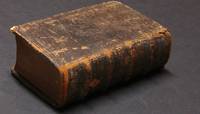
|
|
|
ROLLIN Ch.
Histoire ancienne des �gyptiens des Carthaginois des Assyriens des Babyloniens des Medes et des Perses des Macedoniens des Grecs. Par M. Rollin ancien Recteur de l'Universit� de Paris Professeur d'�loquence au College Roial & Associ� � l'Acad�mie Roiale des Inscriptions & Belles Lettres. Nouvelle �dition.
Paris Chez la Veuve Estienne Libraire 1733 - 1738. 12mo. 13 volumes: 1: XLVIII61014; 2: IV65113; 3: VIII76716 folding map; 4: VIII59817 folding map; 5: VIII65014; 6: IV73214 folding map with tear; 7: IV65015; 8: VIII72610 folding plate; 9: IV6136; 10: IV45113; 11 consisting of 2 parts: VIII7824 2 folding tables; 12: XII76810; 13: VIII2177302 index p. Contemporary calf 17 cm Ref: The bibliographic reference works mention several editions in 12mo 8vo and 4to Details: Backs gilt and with 5 raised bands. Two shields on each back. Marbled endpapers. The first 6 volumes of our copy are reissues of the first edition for on the first 6 title-pages is printed 'nouvelle �dition Condition: Boards and backs worn and bumped at the extremities. The joints of the first two volumes are starting to split. Upper margin of the 11th volume partly waterstained Note: The French ancient historian and educator Charles Rollin 1661-1741 was famous in his time appreciated by Voltaire and Montesquieu but forgotten by later generations. Only in England his popularity lingered on well into the 19th century. Nevertheles is his contribution to classical scholarship of importance for the development of Greek history as an elaborate intellectual construct. Neue Pauly vol. 14189 In 1687 Rollin was appointed professor of rhetoric at the 'Coll�ge du Plessis' in 1688 professor of eloquence at the 'Coll�ge Royal'. He was elected in 1694 Rector of the University of Paris and in 1701 member of the 'Acad�mie royale des inscriptions et m�dailles'. Rollin was hindered in his career by his religious Jansenist opinions. In 1720 after his reelection to Rector of the University of Paris he fell victim to a 'lettre de cachet' and was forced to step down. The second part of his life he consecrated to education and the study of ancient history. His monumental 'Histoire ancienne des �gyptiens des Carthaginois des Assyriens des Babyloniens des M�des et des Perses des Mac�doniens des Grecs' commonly known as 'Histoire Ancienne' published in Paris between 1730 and 1738 in 13 volumes was his greatest contribution to scholarship and a success too. His other great work the 'Histoire Romaine' appeared in Paris 1738-1748. Rollin's historical works are now considered compilatory uncritical and somewhat inaccurate. His 'Histoire Ancienne' was translated into German Italian Dutch and English. Especially the English translation proved a tremendous success. So it is appropriate that the English Wikipedia article on Rollin states that his Histories 'instructed and interested generation after generation' Photographs on request Heavy book may require extra shipping costs hardcover
Referência livreiro : 120326
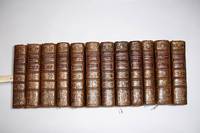
|
|
|
VALERIUS MAXIMUS.
Valerii Maximi Dictorum factorum memorabilium lib. IX cum I. Lipsii notis et indice uberrimo.
Amsterdam Amstelodami Apud Ioannem Ianssonium 1647. 12mo. XII48626 index p. Modern calf 14 cm Ref: Schweiger 21110; Graesse 6/2245 Details: 20th century new binding antique style. Back with three raised bands. Gilt short title in second compartment. Marbled endpapers. Engraved title: a woman holding in her hands a balance scale and reins. Woodcut initials. Edges of the book-block dyed blue Condition: Back spotted. Title page thumbed. Lower margin of the blank front flyleaf damaged. A few small wormholes in the lower margin of the title page outside the engraving. Two small wormholes near the gutter of the first 3 leaves nibling at a few letters Note: The Roman historian Valerius Maximus who lived during the reign of the emperor Tiberius composed a manual of illustrative examples for rhetoricians the Factorum ac dictorum memorabilium libri IX. 'The subject-matter of the nine books has no clearly defined plan but is divided under headings mostly moral or philosophical in character e.g. Omens Moderation Gratitude Chastity Cruelty which are usually illustrated by Roman domestica and foreign externa examples. . The work is shallow sententious and bombastic full of the boldest metaphor and rhetorical artifices of the Silver Age. . Yet the variety and convenience of the compilation ensured some measure of success in antiquity and considerably more in the Middle Ages'. OCD 2nd ed. 1106 Medieval education drew heavily from classical authors for pagan learning was necessary for understanding the Scripture. The focus often was on memorizing sententiae and offering exempla and anecdotes that exemplified virtues. The critical and historical approach of the Renaissance to the school curriculum eliminated most post-classical authors in favor of 'Cicero for rhetoric Virgil for poetry and Caesar Valerius Maximus or Sallust for history on the argument that antiquity provided the best models for understanding people and their place in society'. The Classical Tradition Cambr. Mass. 2010 p. 294 � This edition of 1647 by Johannes Janssonius is a reissue of the Valerius Maximus edition of Leiden publisher Hegerus of 1640. The notes are by the humanist scholar Justus Lipsius 1547-1606 which were first published by Plantin in 1585. Lipsius consulted for his notes two new manuscripts. Lipsius was probably interested in Valerius Maximus as source for his own Monita et exempla politica 1605 Provenance: On the front flyleaf the owner's inscription: J. Piper Gryphiae 1778. This probably is Johannes Gottfried Piper a German Schulmann and paedagogue who studied in Greifswald. Till 1792 he was Rector at Ribnitz a small city in Mecklenburg-Vorpommern. He died in 1814. J�cher Allgemeines Gelehrten-Lexicon Bremen 1819 Volume 6 p. 248 � On the front flyleaf in ink the name Groskurd. This is probably the German classical scholar Christoph Gottlieb Groskurd born 1770 who died in 1834 in Stralsund. 'Ab 1790 studierte er in G�ttingen bei den Professoren Gottlieb Jakob Planck Johann Friedrich Schleusner und Johann Gottfried Eichhorn protestantische Theologie sowie bei den Professoren Christian Gottlob Heyne Arnold Hermann Ludwig Heeren Johann Georg Heinrich Feder Christoph Meiners Anton August Heinrich Lichtenstein und Splitter klassische Philologie. Von 1793 bis 1797 war er Kollaborator am P�dagogium in Ilfeld. Von 1797 bis 1823 unterrichtete er die Tertia am Stralsunder Gymnasium. Er trat 1823 wegen einer schweren Erkrankung in den Ruhestand und widmete sich darauf den Studien der Werke des Strabon'. Source Wikipedia � On the frontflyleaf also the inscription: Cunow in Potsdam. � A former owner probably the one who had this binding restored outlined his name in the blue paint at the right edge of the book-block: F. Gutheil Collation: 6 A-X12 Y4 Photographs on request hardcover
Referência livreiro : 120434
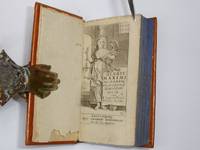
|
|
|
SLEIDANUS I.
I. Sleidani De quatuor summis imperiis libri tres; Postrema editione hac accurate recogniti.
Amsterdam Amsterodami Apud Ioannem Ianssonium n.d. between 1631 and 1664 8vo. 309241 blank p. 12mo. Vellum 12 cm Details: Back with 4 raised bands. Two thongs laced through the joints. Engraved title depicting some mythological figures and a small portrait of Alexander the Great Condition: Vellum age-toned. Front flyleaf gone. Three pinpoint holes on the rear joint. A small tear in lower margin of title which is thumbed. Paper foxed and with some brown stains. One old ink annotation Note: The German humanist diplomat and historian Johannes Sleidanus Sledanus Sleidan was born between 1506 and 1508 in Schleiden hence his name a city South of Cologne. He is best known for his 'De statu religionis et reipublicae Carolo Quinto Caesare Commentarii' published in 1555 which made him the historian of the Reformation. It was so impartial that it pleased no one. The book was placed by the pope on the Index and the Lutherans were not pleased either. Still it remains the most valuable contemporary history of the times of the Reformation and it contains the largest collection of important documents. Less controversial is Sleidanus world history 'De quatuor summis imperiis babylonico persico graeco et romano' published in the year of his death 1556. NDB 24 499/500 The idea of four empires is an old one. In the Old Testament an angel tells Daniel who was in slavery in Babylon how to interpret a dream he had. Daniel had dreamed of a winged lion a ferocious bear a panther with four wings and four heads and an unnamed alien monster with iron teeth that devoured everything. The angel: 'These four great beasts are four kings who shall arise out of the earth'. On the day of judgement the last of the four kings will lose his power and will vanish and the kingdom will be given to the saints. Late medieval exegesis explained the fours beasts as follows the lion was the Babylonian kingdom the bear was identified as the dominion of Persia and the winged panther was the reign of Alexander and his diadochi. The beast with the iron teeth was the Roman empire. All these kingdoms stood on feet of clay. As the divine vision of Daniel provided only for four kingdoms the Holy Roman Empire of Sleidanus' days had to be a continuation of the Roman Empire of the past. The German emperors with the divine legitimation of the Bible continuated merely the Roman empire. Sleidanus' historical chronicle is based on the order as revealed in Daniel's vision. 'His concern is the historical legitimation of the German imperial reign through its continuity with the Roman empire'. He thus gave biblical dignity to the German imperial constitution and thus legitimated the protestant Reformation. W. Schmidt-Biggemann 'Philosophia perennis: Historical Outlines of Western Spirituality in Ancient Medieval and Early Modern Thought' Dordrecht 2004 p. 399-400 This world history of Sleidanus was immensely influential. In the next 150 years more than 60 editions were published. Sleidanus succeeded in creating with both his historical works a common historic identity for the protestants in a hitherto Catholic world. History had at the beginning of the Reformation to be repossessed and rewritten to underline the Protestant claim for legitimacy and authority. His History of the four Empires contained enough condemnations of the popes to suit the taste of his public. This undated Janssonius edition is probably a pirate edition of an Elzevier production published between 1631 and 1664 the year Janssonius died. Willems no. 358 dated 1631 no. 763 dated 1655 & no. 1179 dated 1654. All three Elzeviers editions have the same number of pages as this one of Janssonius Collation: A-X8 leaf X8 verso blank Photographs on request hardcover
Referência livreiro : 120029
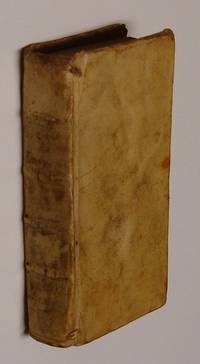
|
|
|
SALMASIUS C.
Funus Linguae Hellenisticae sive Confutatio exercitationis de Hellenistis et Lingua Hellenistica. Cui libet exequias ire Hellenisticae i licet. Ecce illa iam effertur. And from page 281: 'Ossilegium Hellenisticae sive Appendix ad confutationem Exercitationis De Hellenistica'
Leiden Lugduni Batavorum Ex officina Ioannis Maire 1643. 8vo. 3901 corrigenda1 blank p. Vellum. 8vo. 16.5 cm. Ref: Breugelmans 1643:10; Graesse 6249; Berghman 704; Rahir 1920; Ebert 20118; Brunet 6 no. 10665; cf. Willems 558 Details: 5 thongs laced through the joints. Woodcut printer's mark of Maire on the title depicting a farmer who stamps a shovel into the ground; above his head the motto 'fac et spera'. Page 1-280: Funus Linguae Hellenisticae page 281-390: Ossilegium Hellenisticae Condition: Vellum age-toned. One gathering foxed Note: The French scholar Claude de Saumaise latinized Claudius Salmasius 1588-1653 was a prolific author and he distinguished himself in his editions as a textual critic and erudite commentator. He was easy to get along with but haughty and murderous on paper. In 1623 he was appointed as the successor of Scaliger at the University of Leiden a city he was going to hate. This Funus linguae Hellenisticae of 1643 is a stage in the ongoing quarrel between the Leyden professors Daniel Heinsius once the favourite of Scaliger and Salmasius. When Heinsius published his Sacrae Exercitationes ad Novum Testamentum in 1639 Salmasius saw an opportunity to take 'revenge on the man he viewed as the leader of the coterie opposing him at Leiden'. P.R. Sellin 'Daniel Heinsius and Stuart England' Leiden/Oxford 1968 p. 43 In the preface of his De Modo Usurarum of 1639 he ridiculed Heinsius' description of the koin� as 'lingua Hellenistica'. A flurry of polemics followed. In this quarrel the printer Maire sided with Salmasius in his attempts to destroy Heinsius' integrity. Sellin p. 47 With his De lingua Hellenistica et origine ac dialectis graecae linguae of 1643 Salmasius mounted a full-scale assault on Heinsius position on the koin� followed in the same year by a still fiercer attack De Hellenistica commentarius controversiam de linguae hellenistica decidens and this anonymously published attack on his colleague the Funus Linguae Hellenisticae. In it Salmasius contended that the language of the Greek Scriptures was not a separate dialect but the ordinary Greek of his time. Sandys A History of Classical Scholarhip N.Y. 1964 volume 2 284/86 Concerning the De Hellenistica commentarius which was published by Elzevier and the Funus Linguae Latinae both written by Salmasius we quote part of an excellent note of Willems p. 138 no. 558: 'On appelait Hell�nistes les Juifs dispers�s parmi les Grecs surtout ceux qui habitaient Alexandrie et parlaient habituellement le grec. Partant de l� certains savants � l'exemple de Daniel Heinsius dans son Aristarchus sacer s'�taient crus autoris�s d�signer sous le nom d'hell�nistique le langage m�l� d'expressions et de tours de phrases h�bra�ques qui �tait usit� parmi ces m�mes Juifs et dans lequel sont �crits la version des Septante et le Nouveau Testament. Saumaise qui trouvait l'expression impropre composa ce gros volume De Hellenistica commentarius contre ceux qu'il appelle les Hell�nisticaires et notamment contre Daniel Heinsius quoique celui-ci ne soit pas nominativement d�sign�. Il n'en resta pas l�; car d�s la m�me ann�e il donna encore le Funus linguae hellenisticae suivi de l'Ossilegium hellenisticae Lugd. Bat. J. Maire 1643. L'auteur a beau jeu pour d�montrer que le terme d'hell�nistique est inconnu � toute l'antiquit� que cette langue ne constitue pas � proprement parler un dialecte sp�cial qu'il n'y a en grec que quatre dialectes ou cinq si l'on y comprend la langue commune &c. A cet �gard son livre est plein de vues nouvelles et ing�nieuses dont les grammairiens ont fait leur profit. Mais le fait que les livres saints sont �crits en un idiome dont les mots sont grecs et la phrase h�bra�que n'en subsiste pas moins et Saumaise en convient. . Quoi qu'il en soit le mot qui �chauffait si fort la bile de Saumaise a fait fortune car les r�cents linguistes Matthiae K�hner &c n'ont pas fait difficult� de l'admettre' Provenance: On the front pastedown in pencil: 'J. v. Dijck' Collation: A-2A8 2B4 leaf 2B4 verso blank Photographs on request hardcover
Referência livreiro : 120157
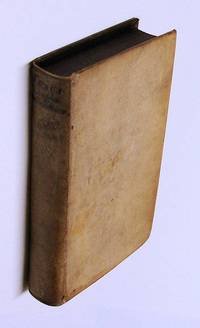
|
|
|
QUINTILIANUS.
M. Fabii Quintiliani Institutionum oratoriarum libri duodecim summa diligentia ad fidem vetustissimorum codicum recogniti ac restituti. Novae huic editioni adiecit Fabianarum notarum spicilegium subcisivum Daniel Pareus Phil. Fil. Accesserunt etiam Quintilianorum declamationes.
London Londini Typis E.G. Impensis R. Whitakeri 1641. 8vo. 2 parts in 1: 5696 index1 blank; 7222 blank; 58 index2 blank p. Modern half vellum 18 cm 'Practical humane fascinating still of signifance'. Ref: ESTC Citation No. R16191; Schweiger 2839; Fabricius/Ernesti 2273; cf. Graesse 5527 for the edition Franktfurt 1629 with exact the same title Details: Back with 3 raised bands Condition: Endpapers renewed. Old ownership entries and some small notes on the title. Paper yellowing. Right lower corner of 3/4 hardly visibly waterstained. Small hole in the blank margin of p. 13/14 Note: The Roman orator Marcus Fabius Quintilianus ca. 35 - ca. 100 A.D. was under emperor Vespasian probably the first holder of the chair of Latin rhetoric in Rome paid by the fiscus. salarium e fisco accepit Suetonius Vesp. 17-19 His most celebrated work is the 'Institutio Oratoriae' in 12 books. It 'covers the complete training of the orator from the earliest preparation by the grammarian to his most mature aspirations for oratorical preeminence'. The Classical Tradition Cambr. Mass. 2010 p. 827 The ideal was a public speaker who was skilled not only in eloquence but who was also a good man. This is summarized in the famous maxim that an orator is a 'vir bonus dicendi peritus'. Quintilian still makes all that has been written on education from Rousseau to the latest pseudo-psychologist rather worthless. H.J. Rose A handbook of Latin literature London 1967 p. 399 'Book 1 discusses childhood education. . In book 2 the boy enters the school of rhetoric'. In book 3 follows an account of the art of rhetoric 'its origin its parts and its functions. Book 4-6 deal with the detailed structure of a speech . Book 7 is concerned with arrangement dispositio and status-lore. Book 8 discusses style . while in book 9 figures of thought and speech are illustrated'. Book 10 contains a critique of Greek and Latin writers. 'Book 11 discusses memory delivery gesture and dress . The concluding book shows the complete Orator in action a man of highest character and ideals . Roman gravitas at its noblest'. OCD 2nd ed. p. 907 The 19 'Declamationes maiores' which have come down to us under the name of Quintilian are certainly not his work. The 'Declamationes minores' a corpus of 145 smaller rhetorical exercises are probably the work of a contemporary rhetorician. � The 'Institutio Oratoria' of Quintilian was known throughout the Middle Ages especially in the summarizing works of the encyclopedists like Cassiodorus and Isidorus of Sevilla. In 1416 the Italian humanist Poggio Bracciolini discovered in Sankt Gallen a complete text after which Quintilian came 'to exert a deep and lasting influence on rhetorical theory and practice'. The Classical Tradition p. 829 The treatise influenced authors like Erasmus and Vives. The humanist Poliziano lectured on him and Lorenzo Valla preferred him to Cicero. His ideas were absorbed by Piccolomini Agricola Erasmus De pueris instituendis and Melanchthon. He was also used by Ben Jonson Discoveries Alexander Pope Essay on criticism Du Bos and Goethe. 'Seine Wirkung geht mit der Verfehmung der Rhetorik im 19. Jh. zur�ck doch bleibt Quintilian eine respektierte Gr�sse bis heute'. Neue Pauly 10719 � Daniel Pareus German philologist historian and schoolmaster son of the classical scholar Johann Philipp Pareus was born in 1605. He must have been a young scholar of some promise for the Dutch professor Gerard Vossius who endeavoured to find publishers for his works failed to gain him a professorship in the Netherlands. He then went to Kaiserslautern and founded there a Latin School but not yet 30 years old he was in 1635 murdered at the occupation of that city by soldiers or stabbed by a gang of brigands. In his short career he produced an edition of Musaeus 1627 Herodian 1627 'Mellificium Atticum' a collection of sentences of Greek authors reduced into commonplaces 1629 notes on Quintilian first published in 1629 Heliodorus's Aethiopica notes on Lucretius. He added his 'Animadversiones' to his father's edition of Sallust. His historical works are: 'Universalis historiae profanae medulla' 1631 'Universalis historiae ecclesiasticae medulla' 1633 and his excellent 'Historia Palatina' on the history of the 'Pfalz' 1633. ADB 25167 Provenance: On the title in faint ink: 'Sum conventus Angiae' and 'Bibliothecae Augustianae Angiae' and 'Fr. Jodocus Anthonii Ord. Eremit. S. Augustini' who wrote also beneath the imprint 'Requisitus Lovanii 1643' and 'Fr. Leverd prior'. The city of Enchien Flemish Edingen in the province Hainaut Belgium once housed a convent of the 'Ord. FF. Eremitarum S.P.N. Augustini'. This Augustine convent rue des Augustins no. 2 still is a monument. Frater Jodocus perhaps was the librarian of the convent he records that it was acquired in Louvain in 1643. � On front flyleaf the name of 'Lennart Hakanson' 1939-1987 professor of Latin at the university of Uppsala. He published in Lund in 1974 'Textkritische Studien zu den gr�sseren Pseudoquintilianischen Deklamationen' Collation: A8 -A1 B-2N8 leaf 2N8 verso blank. A-2Y8 between 2O and 2P has been inserted a gathering of two leaves signed pp; leaf 2Y8 blank; 3A-3C8 3D6 leaf 3D6 blank � There are two issues of this edition of 1641: ESTC R233485 and ESTC R16191. The first one starts with the 'Institutio Oratoriae' followed by the 'Declamationes' the other is the other way round first the Declamationes and then the 'Institutio Oratoriae'. R16191 calls for a title page with a heart-shaped ornament and with the printer's error 'accesserum' instead of 'accesserunt'. Our copy has the construction of R16191 but has the title page of R233485 which shows a flower-shaped ornament and has the corrected 'accesserunt'. This title page is a cancel this means that the faulty title was removed and replaced by another corrected title Photographs on request hardcover
Referência livreiro : 120120
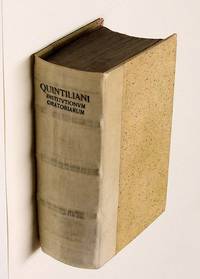
|
|
|
ROUS F.
Archaeologiae Atticae libri septem dat is: Seve boeken van de oudheden van Attika zijnde een beschrijving van des Stadts heerlijkheyt stijl van regeering verdeeling van volk en van steden vlekken en plaatsen die op den Atheenschen bodem lagen. Ook van hunnen godtsdienst bygeloovigheyt offerhanden en jaar-rekeningen; mitsgaders een volstrekt verhaal hunner vierscharen en een by-voegsel van de gewoontens die in gebruyk waren by hun trouwen begraven van dooden gastmaalen wichelaryen en van diergelijke dingen meer. In 't Engels beschreven door Francis Rous van Mortons sic Collegie tot Oxfort en in 't Nederduyts gebragt door Henrikus van Rhenen predik. tot Jutfaas.
Amsterdam By Hendrik en de weduwe van Dirk Boom 1688. 8vo. XII including the frontispiece759241 blank p. Vellum 16 cm Details: 5 thongs laced through both joints. Frontispiece it depicts four men with a turban on their head discussing before a map of Attica. Woodcut initials throughout Condition: Vellum soiled. Name on frontispiece; 2 round stamps on title One oval stamp on the verso of the title Note: Francis Rous the Younger 'born at Saltash in 1615 and educated at Eton and Oxford where he matriculated on 17 October 1634 and was elected to a postmastership at Merton College the same year. He afterwards migrated to Gloucester Hall. About 1640 he settled in London where he practised medicine until his death in or about 1643. He contributed to Flos Britannicus veris novissimi filiola Carolo et Maryse nata xvii. Martii 1636 and compiled Archaeologiae Atticae Libri Tres 1637 & 1645; third edition with four additional books by Zachary Bogan under the title Archaeologiae Atticae Libri Septem Oxford 1649 and frequent reprints the last 9th edition at London in 1688'. Dictionary of National Biography volume 49 p. 317 Provenance: On the frontispiece: 'H. Hofsnider'. Hofsnyder or Hofsnider 1671-1744 was a Dutch historian and book collector who published on the history of Groningen. DBNL Repertorium van geschiedschrijvers in Nederland 1500-1800. � On the title 2 round stamps of 'Practizyns Societeit'. This Society still exists in Amsterdam. It's members are lawyers and jurists. � Also the name of 'L. Gaillard' on the title. We found one 'L. Gaillard' in the 'Staatsalmanak voor den jare 1826' Den Haag 1826 p. 386 who was a lieutenant-colonel in the Dutch army and military commander of the city of Leuven. � On the verso of the title: 'Bibliotheek E. de Markas'. There was a lawyer of that name in the beginning of the 19th century in Amsterdam. He was a member of Arti et Amicitiae Collation: 6 A-3C8 leaf 3C8 verso blank Photographs on request hardcover
Referência livreiro : 120402
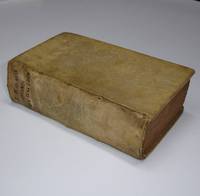
|
|
|
SCYMNUS.
Marciani Heracleotae PERI�G�SIS seu Orbis descriptio cum interpretatione latina ad verbum & notis Erasmi Pauli F. Vindingii.
Copenhagen Hafniae Literis Henrici G�diani Reg. & Academ. typographi 1662. 8vo. I301;36 leaves. Calf 15 cm Ref: Hoffmann 2580; Schweiger 1204; Graesse 4384; Ebert 13049; Brunet 31403 Details: Back skillfully repaired in antique style with 5 raised bands. Boards with double fillet gilt borders. Marbled endpapers Condition: Edges of boards worn corners bumped. A bookplate on the front pastedown Note: The Periegesis ad Nicomedem regem is a didacted poem in iambic verse that is falsely attributed here to the ancient geographer Marcianus Heracleota Heracleensis and that was later known though again without any foundation under the name of Scymnus Chius. Nowadays it goes under the name of Pseudo-Scymnus. Marcianus Heracleota lived in the 5th century A.D. The poem is dedicated to Nicomedes king of Bithynia. This is probably Nicomedes III a monarch who reigned from 91 to 76 B.C. Scymnus of Chios lived before Nicomedes III. What is left of the poem was first published in 1600. This 1662 edition numbers 746 verses. The edition of Meineke of 1846 already numbered 978 verses and the edition of Diller of 1952 has 1026 verses. The portions that have been preserved contain the introduction together with a description of the coastal areas of Europe. The information it offers is based on the ancient geographers Theopompus and Ephorus and gives a picture of the Hellenic oikumene. The book was designed as a popular compendium for general use. 'But while its writer gives a long list of authors whom he had consulted or professed to consult he was wholly without the critical skill to compare and discriminate between his different authorities or to discard the statements of earlier writers which the progress of geographical knowledge had shown to be erroneous. . The consequence is that his book in stead of representing the state of geographical knowledge in his own day is a jumble of confused statements belonging to wholly different periods. By far its greatest value at the present day arises from the notices . concerning the foundation of the different Greek colonies and cities on the coast of the Mediterranean'. E.H. Bunbury A history of ancient geography London 1879 vol. 2 p. 71 � The Danish editor Paulus Vindingius acknowledges at the beginning of his commentary that the Periegesis can not be the work of Marcianus Heracleota to whom the Codex Palatinus wrongly attributes the work. A vetus scriptor wrote this poem at least 425 years before Marcianus Heracleota he argues and no author of that name was known in the 2nd century B.C. Vindingius cannot agree with Holstenius 1630 that the author is Scymnus of Chios. Why the poem is nevertheless presented on the title-page under the name of Marcianus Heracleota is a riddle. � The Danish scholar Rasmus Vinding latinized Erasmus Vindingius Pauli Filius 1615-1684 was since 1648 professor of Greek at the University of Copenhagen Wikipedia German edition Rasmus Vinding Provenance: Woodcut bookplate Ex libris M.A. Elton of the English book collector Mary Augusta Strachey Elton 1838-1914 pasted on the front pastedown. She published in 1891 A catalogue of a portion of the library of Charles Isaac Elton and Mary Augusta Elton and together with her late husband Charles Isaac Elton described in the Dictionary of National Biography as perhaps the most erudite lawyer of his generation in 1893 The great book-collectors. This Periegesis is not to be found in the first work. The motto on the bookplate is: Non norunt haec monumenta mori. Martial x.ii.12 These monuments do not know how to die Collation: a-d8 A-D8 E4 Photographs on request hardcover
Referência livreiro : 120432
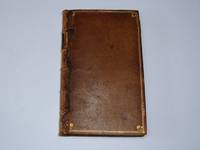
|
|
|
TACITUS.
P. Cornelii Taciti equitis romani Annalium ab excessu Augusti sicut ipse vocat sive Historiae Augustae qui vulgo receptus titulus est libri sedecim qui supersunt partim haud oscitanter perlecti partim nempe posteriores ad exemplar manuscriptum recogniti magna fide nec minore iudicio per BEATUM RHENANUM. . Libellus de Germanorum populis Dialogus de oratoribus denique Vita Iulii Agricolae non solum emaculatius prodeunt sed & explicatius adiunctis in hand rem scholiis. . Nec desunt aliorum in hunc autorem ante aeditae annotationes praefationesque sive Beroaldi seu Alciati.
Basel Basileae In Officina Frobeniana 1533. Colophon at the end: 'Basileae In Officina Frobeniana per Hieronymum Frobenium et Nicolaum Episcopium 1533' Folio. LXXII49224 p. Half calf late 19th century 30 cm Ref: VD16 T 13; Neue Pauly Suppl. 2 p. 574; Schweiger 2998/99; Dibdin 2449/50; Moss 2641; Fabricius/Ernesti 2395; Brunet 5634; Ebert 22142; Graesse 6/28; USTC no. 681875 Details: Gilt back with a red lettering label. Edges dyed red. Large printer's mark of Froben on the title and last page. Several woodcut initials in the text some small some larger Condition: Many contemporary marginal notes and underlinings on the first 170 pages. The notes have been slightly trimmed by the 19th century binder. The title leaf has been laid down first 8 leaves neatly repaired at the top of the inner margin. Partly waterstained in the beginning and at the end quite heavily. The last leaves have a few light spots of moulding. Paper yellowing and foxed in places. Inkstains and two scratches on the frontcover; a few scratches on the back Note: 'The best of 3 Tacitus editions of Frobenius'. The colophon on the recto of the last leaf specifies the title page: 'Basileae in Officina Frobeniana per Hieronymum Frobenium et Nicolaum Episcopium 1533' . Basel was in the 16th century one of the most important centres of humanism. 'Humanism was there fostered by the University founded in 1460 while classical texts were issued by at least 3 printing-presses 1 that of Johannes Froben 1491 who was succeeded in 1527 by his son Hieronymus and his son-in-law Episcopius; 2 that of Cratanter1518 subsequently managed by Oporinus 1544; and 3 that of Hervagius 1531. The texts were founded on MSS from the monasteries of Alsace and the Palatinate and some of them are now the only evidence as to the readings of those MSS'. Sandys 'A history of classical scholarship' N.Y. 1964 vol. 2262 � The text of Tacitus owes much to the corrections of the Alsace scholar Beatus Rhenanus of Schlettstadt 1485-1547 'who was distinguised for his fidelity to the readings of the manuscripts and for his critical caution in admitting conjectures'. Idem p. 2263 His best editions were published in Basel the 'editio princeps' of Velleius Paterculus 1520 Seneca's 'Apocolocyntosis Divi Claudii' also called 'Ludus de morte Divi Claudii' 1515 and his Tacitus which was first published by the father of Hieronymus Johannes Froben in 1519. For the text of his Tacitus Rhenanus used the 'aeditio vulgata' of Beoraldus published in Rome in 1515 in which the first 5 books of the Annals were published for the first time. For this second edition of 1533 Rhenanus tells in the preface dated 1532 he thoroughly went through the text once more percurri non prorsum indiligenter and made some corrections quaedam accuratius excussi. Rhenanus tells also that he made use for this second edition of a manuscript which king Matthias Corvinus king of Hungary 'Martis & Palladis studiis inclytus' had once donated to his friend Jacob Spiegel. Preface laef aa3 recto The text of the works of Tacitus is preceded by a learned treatise of Rhenanus of 64 pages: 'Thesaurus locutionum constructionumque vocum Tacito'. At the end we find 14 pages with the notes of the Italian humanist jurist and classical scholar Andrea Alciato Andreas Alciatus 1492-1550. Alciatus is best known for his famous Emblematum liber Augsburg 1531 which saw numerous reissues and revisions and imitations. The firm of Froben published in 1544 a reissue of our 1533 edition Provenance: From the Rostagni Library. 'The Rostagni private library has been built over a time of 133 years between 1880 and 2013 by 3 generations of collectors: Augusto Gabinio 1863-1939 internist his nephew Augusto Rostagni 1892-1961 classical philologist at the University of Turin and his son Luigi Rostagni 1932 Operational Director. . Augusto Rostagni thaught Ancient literature in various Italian Universities. In 1928 he was appointed professor in Latin literature at the University of Turin an office he fulfilled until his death in 1961. He became one of Italy's most authorative philologists of the 20th century. He held positions of President of the Turin Institute of Classical Philology Dean of the Department of Literature and Philosophy Editor of the Rivista di Filologia Classica President of the 'Accademia delle Scienze di Torino'. He was a well-known member of many Italian and foreign academies and institutions amongst them the Accademia dei Lincei. The Department of Philology Linguistics & Classical Tradition of the University of Turin is named after him.' Burgersdijk & Niermans Auction sale 340 Leiden 2014 p.68 Collation: aa-ff6 a-z6 A-V6 Photographs on request Heavy book may require extra shipping costs unknown
Referência livreiro : 152323
|
|
|
REITZIUS JF. J. F.
Dictata Viri Celeberrimi atque Clarissimi J.F. Reitzii in Nieupoortii Compendium Antiquitatum Romanarum.
No place no date. 4to. 644 p. Half calf 21.5 cm Ref: Haitsma Mulier 352 Details: 18th century manuscript lecture notes of an anonymous written in Latin in a fair copy book. The hand is clear even pleasant and legible. The text is mostly written on the recto side of the leaves. The back of the binding is richly gilt and has 5 raised bands. The shield in the second compartment reads: 'Cl. Reitzii in Nieup. Antiq. Rom. Dictata' Condition: Back somewhat rubbed. Foot of the spine slightly damaged. Paper on both boards completely gone Note: This manuscript contains the college notes of Johann Friedrich Reitz Johannes Fredericus Reitzius which were to accompany his lectures on Roman Antiquities based on Nieupoort's manual of Roman antiquities 'Rituum qui olim apud Romanos obtinuerunt succincta explicatio ad intelligentiam veterum auctorum facili methodo conscripta'. Nieupoort's book is in the title of this manuscript indicated as 'Nieupoortii Compendium Antiquitatum Romanarum'. The notes follow closely the chapters and paragraphs of Nieupoort. � The Dutch jurist and ancient historian Willem Hendrik Nieupoort 1670/1674-1724 earned his keep as self-supporting teacher in Utrecht with private tuition. He is remembered for his 'Rituum . succincta explicatio' which was first published in 1712. Nieupoort published during his lifetime in 1716 and in 1723 a second and third corrected edition. An enlarged and corrected 4th and 5th edition appeared in 1734 and in 1747 both produced by the Dutch schoolmaster of German origin Wilhelm Otto Reitz first praeceptor at the Erasmianum at Rotterdam and then rector of the Schola Latina at Middelburg. For the 5th and for the 6th enlarged edition of 1774 Reitz received help from his elder brother Johann Friedrich Reitz 1695-1778 who had studied at Utrecht became conrector/rector of the local Schola Latina and was the last 30 years of his life 1748-1778 professor of History and Eloquence in the University of Utrecht. He is best known for his edition of Lucian which begun by Hemsterhuis he completed in 1743. Sandys 2453 � In the 18th century and well into the 19th century Nieupoort's manual was a classic. It saw dozens of reissues in Holland in Germany and Italy and was translated into French and Portuguese. 'Explication abreg�e des coutumes et c�r�monies observ�es chez les Romains : pour faciliter l'intelligence des anciens auteurs' & 'Usos e costumes dos Romanos por Nieupoort : versao feita sobre o original Latino acompanhada de notas e da traduccao dos termos Grecos' A contemporary review of the 4th edition of 1734 stresses the advantages of Nieupoort's 'Rituum . succinta explicatio'. There are many learned introductions to the Antiquities of Rome it is stated but most of them are too long too chaotic and complex and too overloaded with an '�talage d'�rudition'. 'L'exp�rience fait assez voir que pour lire avec fruit & avec plaisir les anciens auteurs Latin & Grecs il faut avoir au moins une id�e g�n�rale de la R�publique Romaine de ses Magistrats Politiques & Militaires de la Religion des Romains de leurs Loix de leurs Rites de leurs Usages de leurs Co�tumes tant pour la Vie Publique que pour la Vie Priv�e . Sans cela on est arr�t� � tout moment ou bien on croit entendre ce que l'on n'entend pas & l'on se fait de fausses id�es en jugeant des anciens tems par les n�tres'. Nieupoort has succeeded brilliantly in reducing that complicated jumble of Roman history religion and antiquities into a summary 'qui pussent �tre l�s en peu de tems'. And his clear survey improved with every new edition the reviewer adds. 'Biblioth�que raisonn�e des ouvrages des savans de l'Europe' Tome 17/1 Amsterdam 1736 p. 370-376 � Who this fair copy wrote probably somewhere between 1748 and 1778 is not clear. Probably not Reitz for it seems unlikely that he would have called himself in the 'title' 'vir celeberrimus atque clarissimus'. If he had done so he would have called his remarks 'observationes' or the like and not 'dictata'. Furthermore the notes of Reitz do not as far as we have seen appear in the printed text of the 5th 6th or 7th edition hardcover
Referência livreiro : 130239
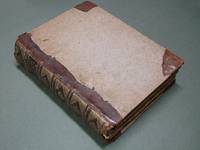
|
|
|
GRAEVIUS JG. J. G.
Jo. Georgii Graevii Praefationes et Epistolae CXX. In usum latinae eloquentiae studiosorum collectae & editae a Jo. Alberto Fabricio D. & Eloqu. Prof. Adjuncta est Petri Burmanni V.Cl. oratio dicta in Graevii funere.
Hamburg Hamburgi Sumtu Christiani Liebezeit Typis Spiringianis 1707. Small 8vo. XVI6373 blank p. Vellum 17 cm Ref: Not yet in VD18; Sandys 2327ff. Details: 5 thongs laced through the joints. Engraved portrait of Graevius before the title made after an engraving of G. Valck of ca. 1705 engraved in its turn after an oil painting by Gerard Hoet painted between 1675 and 1699. Title in red & black Condition: Vellum somewhat spotted. Renewed endpapers; some old ink underlinings; small wormhole in the right margin of the last two blank leaves Note: Johann Georg Graeve or in Latin Johannes Georgius Graevius 1632-1703 was born in Germany and educated at Schulpforta. He was professor of Eloquence at Duisburg from 1657 at Deventer and at from 1662 at Utrecht 'where he lived and worked for the last 40 years of his life'. He limited his attention mainly to writers of Latin prose Cicero Suetonius Caesar Justinus Florus. He is remembered for his 'Inscriptiones antiquae' and famous for his three 'Thesauri' in which important works of previous scholars were collected and reprinted the 'Thesaurus eruditionis scholasticae' 1710 the 12 folio volumes of the 'Thesaurus antiquitatum Romanarum' 1694-99 and the 9 volume 'Thesaurus antiquitatum et historiarum Italiae' 1704. 'The latin style of his prefaces his speeches and his letters is elegant'. The letters contain a treasure of information on classical authors. The German editor of this collection the bibliographer Johannes Albertus Fabricius 1668-1736 was a friend and a great admirer of Graevius. 'Quanta in illo Viro quamque accurata & dilucida cognitio Antiquitatis quanta utriusque linguae peritia'. He is particularly lyrical about Graevius' eloquence and Latin style. 'Eloquentia vero tam singularis tamque exquisita ut sermo ejus a Musis videatur ipsis & Gratiis elaboratus esse'. Dedicatio p. :5 recto Provenance: On the pastedown of the lower board a small label: 'Sammlung Otto Fritz B�hme'. Elke von Radziewsky made of this Collection of the antiquarian bookseller Otto Fritz B�hme a interesting bibliography: 'Sammlung Otto Fritz B�hme Drucke aus Offizinen im Raum der ehemaligen Ost-Hanse' Hamburg Otto Fritz B�hme 1986. It presents more than 1700 entries of publications from the 15th to the 19th century arranged according to printing places from Altona to Zerbst Collation: pi1 portrait 8 minus leaf 8; A-2R8 2R7 verso blank & 2R8 blank Photographs on request hardcover
Referência livreiro : 12029
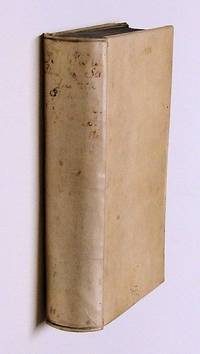
|
|
|
TURSELLINUS H.
De particulis latinae orationis libellus authore Horatio Tursellino Romano e Societate Iesu. Cui Index graecarum latinarum & italicarum vocum locupletissimus praeponitur. Postrema editio summa cum diligentia ab infinitis mendis expurgata.
Milan Mediolani Apud Impress. Archiepisc. 1643. 12mo. 27684 indices p. Limp vellum 15 cm Ref: cf. Brunet 5987; cf. Graesse 6/2216 Details: Woodcut printer's mark on the title it depicts a phoenix which emerges from the flames that come from an round amphora with the initials H.P.P; The amphora is supported by two winged satyrs; the motto is: 'Dela mia morte eterna vita i vivo: semper eadem' Condition: Vellum age-tanned somewhat wavy and soiled. This piece of vellum originates probably from an earlier document. Manuscript title on the back; faint ink on the upper board. Lower board scratched. One paper repair in the index. Both flyleaves removed Note: This booklet 'de ratione colligandi connectendique inter se membra & quasi artus orationis' brought the author the fame he hoped for. Every classical scholar knows Tursellinus that is to say he/she knows and sometimes uses: 'Tursellinus seu de particulis Latinis commentarii' published by the German scholar Ferdinand Gotthelf Hand Leipzig 1829-1845 and reprinted one and a half century later by Hakkert in 1969. This is a very expanded 4 volume adaptation/revision of 'De particulis latinae orationis' published by the Italian Jesuit scholar Orazio Torsellini or Orazio Torsellino or Horatius Tursellinus 1545-1599 for the first time in Rome in 1598. In the short introduction to this edition of 1598 Tursellinus expresses the hope that this book will bring him fame. He cites Vergil's Georgica 46 comparing the art of coherent and polished eloquence with the work of bees: 'In tenui labor; at tenuis non gloria' 'Slight is the field of toil; but not slight the glory'. Translation from the Loeb edition by Fairclough. If you really want praise Tursellinus says for polished speech take care that all parts of it are used as smoothly and and fluently as the joints and the muscles of the body. If you do it right 'Eloquentiae succus sanguis color & quasi robur accedet'. This work offers the student of eloquence the means to speak coherently by the correct use of those small particles and adverbs which glue his speech together. Tursellinus begins with the many uses of 'a vel ab' and ends with 'utique'. A later editor compared the 'particulae' with the 'fibulae' and girdles which are necessary for the 'decora compositio' of our clothes. Tursellinus is highly praised by Sandys. 'It was an exceptional indication of an interest in accurate scholarship in Italy when a treatise on the Latin particles prepared by the Italian Jesuit Horatius Tursellinus b. 1545 was printed at Mainz in 1602 sic! as the first of all the precursors of the elaborate edition published by Hand three centuries after the birth of the original author'. Sandys A History of Classical Scholarship vol. 2 p. 369 Not much is known about Tursellinus. He taught at several Jesuit Colleges in Italy and lectured for 20 year at the 'Collegium Romanum' in Rome. His most important works are a biography of the Jesuit missionary Franciscus Xaverius published in 1596 and a universal history 'Epitome Historiarum libri X' which treated in 10 books the complete history from Adam till 1598 and which remained popular for centuries on schools and universities. For a long time it was used even at the protestant universities in the Dutch republic. 'De particulis' was a tremendous success. A quick search yielded corrected revised and augmented editions in 1599 1602 1611 1618 1619 1643 1648 1651 1657 1663 1682 1689 1701 1703 1709 1713 1719 1724 1734 1750 1751 1769. This Milanese edition of 1643 seems to be rare for we found only one copy in the Catalogo del Servizio Bibliotecario Nazionale. See for Tursellinus 'Biographie Universelle ancienne et moderne' Paris 1826 vol. 46 p. 233/4 Collation: A-P12 Photographs on request hardcover
Referência livreiro : 120177
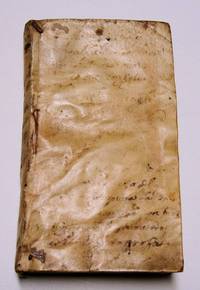
|
|
|
HEINSIUS D.
Laus asini. Tertia parte auctior cum aliis festivis opusculis.
Leiden Lugd. Batavorum Ex Officina Elzeviriana 1629. 24mo. XX4382 blank p. Overlapping vellum 11.5 cm Ref: STCN ppn 832854379; Willems 315; Berghman 1247; Rahir 286; Brunet 384; Graesse 3233 Details: 5 thongs laced through the joints. Engraved title depicting 2 learned gentlemen perhaps Ewaldus Schrevelius to whom the book is dedicated and Heinsius' friend Aldoph Vorstius who doff their hats for an ass Condition: Vellum soiled and scratched. Front board slightly damaged at the upper edge. All four ties gone. Front flyleaf removed. Right edge of the title thumbed very tiny and almost invisible hole in the title Note: The 'Laus asini ad Senatum Populumque eorum qui ignari omnium scientias hoc tempore contemnunt was published anonymously for the first time in 1623. An augmented edition appeared in 1629. The author is according to all critics the Dutch classical scholar and neolatin poet Daniel Heinsius 1580-1655. It pokes fun at people in an Erasmian spirit and seems to have lost none of its topicality. The aim is Heinsius tells in the 'ad lectorem' to vindicate men of letters and those who love to learn from the contempt of ignorant people who not only heartily ridicule liberrime. illudunt them but also culture eruditioni and the sciences. leaf 6 recto & verso This eulogy is a satire on ignorance and voluntary servitude. It is hard to fathom because of the complexity of its style and the overabundance of erudition or put more positively the veritable fireworks of learned allusions which often obscures matters. The first edition of 1623 which contained the 'Laus Asini' only is augmented in this second edition with 6 other pieces 1: an Menippean satire 'Cras credo hodie nihil' 2: 'Epistola qua agitur an & qualis viro literato sit ducenda uxor' 3: 'Laus pediculi ad Conscriptos Mendicorum Patres' 4: 'Epistola de poetarum ineptiis & saeculi vitio' 5: 'Argumentum Batrachomyomachiae' 6: 'Viro Nobilissimo Ioanni Milandro Domino de Poederoeye Principi a Secretis: de Graeculis quos illi commendaverat'. At the end Heinsius added a short letter to H. Grotius and a consolation poem for his friend Baudius on the occasion of the death of his wife Collation: 6 24 A-2N6 2O4 leaf 2O4 blank Photographs on request hardcover
Referência livreiro : 120077
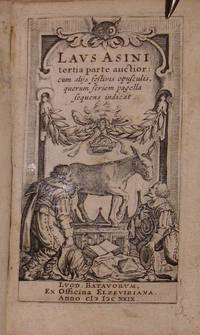
|
|
|
ARISTAENETUS.
Aristaeneti Epistolae graecae cum versione latina et notis Josiae Merceri curante Joan. Cornelio de Pauw cujus notae accedunt.
Utrecht Trajecti ad Rhenum Apud Hermannum Besseling 1737. 4to. XXIV2871 colophon p. Overlapping vellum 15.5 cm Ref: Hoffmann 1240; Schweiger 144; Dibdin 1292; Fabricius Bibliotheca Graeca ed. 4a Hamburg 1780 p. 696; Brunet 1448; Ebert 1066; Graesse 1204 Details: 5 thongs laced through the joints. Title printed in red and black. Woodcut ornament on the title. Greek text with facing Latin translation commentary on the lower half of the page. Edges dyed blue Condition: Vellum slightly soiled. Stamp and name on the front flyleaf. Small part of the right lower corner of the front flyleaf cut off and renewed. Small shelf number in red ink on the title. Two stamps on the verso of the title Note: A survey of erotic motives in the literature of Greece and Rome. Aristaenetus is the established name of the author of a collection of love letters in two books probably from the beginning of the 6th century AD. It survives only in one Codex of which the first folio with the name of the real author is lacking. Aristaenetus Bestpraiseworthy is only applied to the sender of the first letter. This is clearly a case of an imaginary letter-writer. The sources used are Plato Menander Lucianus Alciphron Philostratus the ancient novels and love elegies of Callimachus. Aristaenetus draws however in a conventional way a veil over too explicit love-making. The collection is a kind of survey of erotic motives in the literature of Greece and Rome. Everyting erotic however is covered with a veil of prudery. Aristaenetus ends after some cuddling before the bedroom is entered. Neue Pauly 11087 The collection was allready attributed to Aristaenetus in the 'editio princeps' of Antwerp 1566 edited by J. Sambucus. An edition with a Latin translation was published in 1595 in Paris by Iosias Mercier the 4th edition of which dates from 1639. Mercier was the first to observe that the first letter of the collection was imagined to have been written by one Aristaenetus and that the collection belonged to the genre of imaginative epistolography. Aristaenetus had to wait almost a century for the next edition which appeared in 1736 in Utrecht produced by Jacobus van Lanckom. Exactly the same edition was brought on the market by the Utrecht publisher Hermannus Besseling only the impressum on the title differs the rest is exactly the same. It was said that Aristaenetus was put to sleep in the commentary of Pauw. A revised edition was published in Zwolle in 1749. Cornelis de Pauw born ca. 1680 in Utrecht was canon of the 'Sint Jan'. He was a classical scholar of some repute and published several editions of Greek and Roman authors Hephaestion Horapollo Anacreon Quintus Smyrnaeus Theophrastus's Characters Phrynichus Aeschylus. By some detractors he was considered to be an 'homme m�diocrement savant' whose ignorance was only exceeded by his impudence. He died in 1749 Provenance: On the front flyleaf a stamp: 'Prof.Dr. Joh. Irmscher Berlin NO 55 Erich-Weinert-Strasse 126'. Johannes Irmscher born in Dresden 1920 was a classical philologist and byzantine scholar who made his carreer in the DDR. He died in 2000. On the same flyleaf also in ink: 'C. Schoenemannus Isleb. 1782'. This book once belonged to the German classical scholar and geographer Karl Traugott Gottlob Schoenemann born in Eisleben in 1765. He studied classical philology and ancient geography in G�ttingen. In 1787 and 1788 he published the treatises 'De geographia Homeri' and 'De geographia Argonautarum' . He died prematurely in 1802. Posterity is still thankful for his 'Bibliotheca historico-litteraria patrum latinorum a Tertulliano usque ad Gregorium M. et Isidorum Hispalensem' 1792/94 a still indespensable work of reference for early Christian Latin literature from Tertullian to Isidor of Sevilla. On the title in red ink: 'Ph.H. 85'. On the verso of the title a round stamp of: 'Biblioth. Gymn. Ill. Gothana'. This stamps dates from before 1859. In that year the local 'Gymnasium Illustre' and the 'Herzogliches Realgymnasium' were transformed into the 'Gymnasium Ernestinum Gotha'. See Wikipedia 'Ernestinum Gotha' Collation: 8 24 A-S4 Photographs on request hardcover
Referência livreiro : 120031
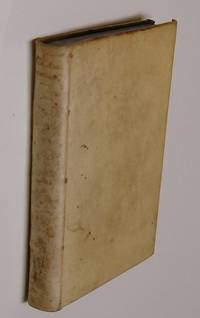
|
|
|
CATULLUS TIBULLUS PROPERTIUS.
M. Antonii Mureti commentarius in Catullum. Eiusdem scholia in Tibullum & Propertium. Bound with: Josephi Scaligeri Iul. Caesaris filii Castigationes in Catullum Tibullum Propertium.
N.pl. 1582. Antwerpen Antverpiae Apud Aegidium Radaeum 1582 8vo. 2 parts in 1: 19262 blank; 2407 index1 blank 19th century hardback 16.5 cm Ref: STCV 12916176 & 12916175; Schweiger 280; Graesse 286; Ebert 3760; Fabricius/Ernesti 193; cf Neue Pauly Suppl. 2 p. 142 for the edition of 1577 Details: Red shield with gilt lettering on the back. This book contains part 2 and 3 of 'Catulli Tibulli Propertii nova editio. Iosephus Scaliger Iul. Caesaris F. recensuit. Eiusdem in eosdem castigationum liber'. It was published in Antwerpen 'Apud Aegidium Radaeum' in 1582. The first part which is lacking in this volume contains the texts of Catullus Tibullus and Propertius. Part 2 and 3 contain the commentary of Scaliger and of Muretus. The date on both half-titles is rather mysterious MDIICII. A mistake for MDXXCII Condition: Binding worn at the extremes and slightly soiled. Paper label with shelf number on the back. Stamp on the first half-title. Occasional old ink marginalia and underlinings Note: This triumvirate of Latin erotic poets was already united in one edition in 1472 published in Venice by Vindelinus de Spira. Editions of the three poets together remained immensely popular through the ages. Schweiger dedicates ten pages with numerous titles to combined editions of these three poets. The commentary of Muretus was published first in Lyon in 1559. The commentary of Scaliger was first published in Paris in 1577 by Mamertus Patissonius 'in officina Roberti Stephani'. This book of 1582 is a reissue of the edition of Paris 1577. The part of Muretus 1559 was added in this edition of 1582. According to the compilers of the Variorum editions of the 17th and 18th century the high quality and general usefulness of the commentaries of Muretus and Scaliger justified their inclusion into those kind of editions which contained the commentary and the annotations taken from leading and normative editions. The French scholar Scaliger 1540-1609 for the first time attempted systematically 'to reconstruct the history of the text of Catullus and to explain the genesis of false readings; in what may be called a partial anticipation of the 'method of Lachmann' he even went so far as to seek to reconstruct an archetype pronouncing on the script in which it must have been written and also where it was written. . Consequently Scaliger's 1577 edition is a landmark in textual studies. . In effect this challenging edition became the textus receptus for the philological epoch to come. Its great leap forward was to amass readings methodically from manuscript evidence thus modifying the practice . of altering the base text by simply examining and comparing the printed editions'. 'Catullus edited with a textual and interpretative commentary by D.F.S. Thomson' Toronto 1998 p. 53 Provenance: On the first half-title the stamp of 'F�rstl. Bibliothek zu Rudolstadt'. The origin of this library lies in the 'Hofkirchenbibliothek' founded at the end of the 16th century. It was transformed into the 'Landesbibliothek des F�rstentums Schwarzburg-Rudolstadt' in the 19th century. The library is still in existence. We quote from the website of Rudolstadt 'Stadtarchiv und Historische Bibliothek': 'Nachdem die F�rstlich-�ffentliche Bibliothek nach 1918 zun�chst als Th�ringische Landesbibliothek Rudolstadt fortbestand begann um 1949 eine Entwicklung die zunehmend zur Vernachl�ssigung des jahrhundertealten Buchbestandes f�hrte. Erst nach 1990 besann man sich in Rudolstadt der �berregionalen Bedeutung seines B�cherschatzes. 1993 erhielten die historischen Sammlungen ihre institutionelle Selbst�ndigkeit unter dem Namen Historische Bibliothek der Stadt Rudolstadt zur�ck. Seit 2003 hat die Bibliothek ihren Standort im Alten Rathaus Rudolstadt'. An extensive history of this library can be found in the online "Handbuch der historischen Buchbest�nde in Deutschland" Collation: A-M8 N4 leaf N4 blank; Aa-Pp8 Qq4 leaf Qq4 verso blank Photographs on request hardcover
Referência livreiro : 120044
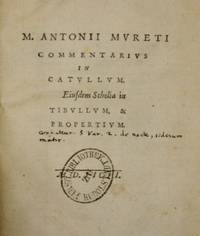
|
|
|
HORATIUS.
Q. Horatius Flaccus ex recensione Heinsii et Fabri ac cum variis lectionibus Rich. Bentleii.
Amsterdam Amstelaedami Ap. R. et G. Wetstenios 1719. 12mo. 2142 blank p. Vellum 12.5 cm Ref: Schweiger 2407; Graesse 3354 Details: 4 thongs laced through the joints. Title engraved by J. Wandelaar Condition: Vellum age-tanned. Both pastedown detached. Right margin slightly thumbed. Engraved title coloured with watercolours. Some old ink underlinings. Faintly waterstained Note: This booklet was produced for schoolboys and educated men able to read Latin but not to be bothered with philological niceties. The Wetsteins had already published an important Horace edition of the English genius Richard Bentley for scholars in Amsterdam in 1713. In a short note p. 5 the 'typographus' Wetstein tells the reader that this booklet offers all that is to be desired for little money paucis accipe. The odes he says are preceded sometimes by an indication of the metre 'ex mente A. Manutii' to make scansion especially for schoolboys tirones easy. For the constitution of the text he follows Daniel Heinsius and Tanaquil Faber. The 'variae lectiones' of Richard Bentley are printed in the lower margins to enable the reader to choose for himself. � The works of the Roman poet Quintus Horatius Flaccus 65-8 B.C. have enjoyed a continuous presence in European culture. Till well into the 20th century he stood central in school curricula. Earlier in the Middle Ages he was next to Vergil the most important school author. Horace is transmitted in around 300 medieval manuscripts. The Renaissance saw the beginning of a flood of editions. 'For Neo-latin poetry until modern times and for all the vernacular literature of Europe from the 16th through the 18th centuries Horace provided the dominant model both for private lyrics celebrating wine and love and for public lyrics celebrating affairs of state'. Young poets used Horace to learn the trade. 'Horace's elegant rationalism and moral wisdom and also his disabused and tolerant tone made his poems favorite reading during the Enlightenment'. The Classical Tradition Cambr. Mass. 2010 p. 454/60 Provenence: Small ownership entry on the front flyleaf: 'F.J.P. Verbrugge'. The Dutchman Franciscus Johannes Petrus Verbrugge was born in Bergen op Zoom and took his doctoral degree 3 july 1973 defending his dissertation 'Versgrens en zin in Ovidius' Heroides'. He has published on Dutch and classical literature especially poetry and on the reception of classical culture in several periodicals. Collation: A-N8; O4 O4 blank Photographs on request hardcover
Referência livreiro : 120083
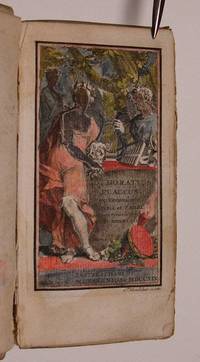
|
|
|
VOET P.
Pauli Voet Gisb. Fil. Juris in Acad. Ultraject. Antecessoris & Vianensis Camerae Senatoris De duellis ex omni jure decisis casubus liber singularis. Editione iterata auctus et emendatus.
Utrecht Ultrajecti Ex officina Johannis � Waesberge 1658. 12mo. VIII384 p. Vellum. 14 cm Details: 5 thongs laced through the joints. Woodcut printer's mark on the title depicting Pallas Athena under an apple tree motto: 'Et flore et fructu' Condition: Vellum soiled and spotted. Fading manuscript title on the back. Front flyleaf removed Note: The Dutchman Paulus Voet latinized as Paulus Voetus or Voetius 1619-1667 was a jurist classical scholar and philosopher. In 1640 he took his Magister's degree and was appointed a year later professor extraordinarius of Metaphysics at the University of Utrecht. There he showed himself an opponent of the philosophy of Ren� Descartes. In the meantime he studied law and got his law degree in 1645. A professorship of Logic and of Greek was offered to him in 1648. In 1645 he had already published his 'In Herodiani Marcum et Commodum Notae'. From 1652 he lectured also on law. He was a member of the Chamber of Justice in the nearby city of Vianen. As a professor of law he has laid with his publications the foundations of international private law as he dealt with the question why a sovereign state should apply foreign law on its territory. In 1646 Voet published the first edition of his work on duels 'De duellis licitis et illicitis liber singularis' in which he examined the phenomenon insult and duel. In 1658 he published a second revised and augmented edition. Voet furiously opposed duelling. Duellist were in his opinion rather meticulosi than audaces men full of fear instead of audacia courage and intrepidity. It would be better if unworthy revilers who insulted men of honour would not be given the opportunity to duel but would be punished with infamia disgrace. If this was done 'non adeo audacter & licentiose conviciatores qui responso digni non sunt in virorum bonorum famam grassarentur'. p. 310 In chapter 35 the last chapter which is on slander he reveals his own involvement. Voet tells how his father and he were once the victim of slander. p. 311/13 He reminds there how the Dukes of Brabant in order to prevent duelling proclaimed 'se offenso honoris reparationem curaturos' that they would secure the honour of those insulted. p. 319 If someone had dealt another soldier a box on the ear alapa colaphus he would receive a box on the ear or a kick in front of his batallion in presentia cohortis would be disarmed and then be sacked Provenance: On the front pastedown: 'Delfosse 1769 Collation: 4 A-P12 Q8 R4 Photographs on request hardcover
Referência livreiro : 120185
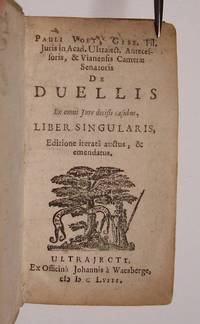
|
|
|
ARISTAENETUS.
ARISTAINETOU EPISTOLAI. Aristaeneti Epistolae graecae. Cum latina interpretatione & notis. Altera editio emendatior & auctior.
Paris Parisiis Apud Marcum Orry via Iacobaea sub signo leonis salientis 1600. 8vo. VIII2822 animadvertenda4 blank p. Limp vellum 18 cm Ref: Hoffmann 1239; Graesse 1204; Ebert 1065 Details: Among bibliographers and librarians there is confusion about the date of this book. The date on the title of this second edition of the letters of Aristaenetus is indicated as MVIC. We found in KVK Karlsruher Virtueller Katalog records of this title dated 1594 1596 and 1600. 1594 is definitely wrong for the Parisian printer Orry published the first edition of this title in 1595 indicated by him as MDLXXXXV and he repeated it the next year now with MDXXXXVI. The third edition was published in 1610 with the date MCX. As the second edition cannot preceed the first edition of 1595 and its repetition of 1596 this second edition comes between 1596 and 1610 so these very unusual Roman numerals MVID 1000 6 500 might well mean 1600. � 2 thongs laced through the joints. The boards and the back have blind-tooled double fillet borders. All 3 edges gilt. On the title the printer's mark of Orry depicting a jumping lion on his way to the top of a steep mountain where a crown of stars awaits him; the motto is: 'Virtus ad astra per aspera'. Greek text with facing Latin translation Condition: Vellum age-tanned and slightly spotted. All 4 ties gone. 1 very tiny hole in the upper board. Small bookplate on the front pastedown. Inscription on the front flyleaf. Small strip of the upper margin of the title with an owner's inscription torn off and repaired. Two other old owner's inscriptions on the title and an owner once added in ink the name of the editor of Aristaenetus 'Josiae Mercerii Des Bordes'. Lower margin stained in places. Some old annotations & underlinings. A small wormhole in the blank lower margin of the last gathering Note: Aristaenetus is the established name of the author of a collection of love letters in two books probably from the beginning of the 6th century AD. It survives only in one Codex of which the first folio with the name of the real author is lacking. Aristaenetus Bestpraiseworthy is only applied to the sender of the first letter. This is clearly a case of an imaginary letter-writer. The sources used are Plato Menander Lucianus Alciphron Philostratus the ancient novels and love elegies of Callimachus. Aristaenetus draws however in a conventional way a veil over too explicit love-making. The collection is a kind of survey of erotic motives in the literature of Greece and Rome. Everyting erotic however is covered with a veil of prudery. Aristaenetus ends after some cuddling before the bedroom is entered. Neue Pauly 11087 The collection was allready attributed to Aristaenetus in the 'editio princeps' of Antwerp 1566 edited by J. Sambucus. An first edition with a Latin translation was published in 1595 in Paris by Josias Mercier des Bordes. Sometimes this edition and the second edition of 1600 is erroneously attributed to the French scholar Jacques Bongars 1554-1612. This cannot be correct for the editor dedicates his Aristaenetus in the 'dedicatio' dated 1595 to Jacobus Bongarsius whom he thanks for his great support. 'Aristaenetum mitto te tandem ut liberem fidem dudum obligatam tibi qui mihi edendi auctor praecipuus.' p. �2 recto Mercier was the first to observe that the first letter of the collection was imagined to have been written by one Aristaenetus and that the collection belonged to the genre of imaginative epistolography. See p. 198/99 of this edition of 1600 This book on offer is the second revised and augmented edition. Besides the text and translation it offers ca. 90 pages commentary. Much more on this French calvinist nobleman and scholar who died in 1626 in 'L'Histoire de La Norville' by l'abb� A.E. Genty 1885 online available at the 'Cercle G�n�alogique Norvillois'Provenance: On the front pastedown the bookplate of the Dutch Jewish physican and famous bookcollector Bob Luza 1893-1980 who survived Bergen-Belsen and whose library was auctioned in 1981 by Van Gendt. Depicted is a book with the initials 'B.L.' on the upper board together with the wellknown symbol of the rod of Asclepius in the background a burning sun. See for Luza P.J. Buijnsters 'Geschiedenis van de Nederlandse bibliofilie' Nijmegen 2010 p. 274-76 � On the title the traces of a name at the upper edge. Below the imprint: 'Radulphi Fornerii J.U.D. Aurelii'. Raoul Fornier or latinized Radulphus Fornerius 1562-1627 sieur de Rondau and 'Juris Utriusque Doctor' at Orl�ans was like his father Guillielmus Fornerius professor of law at the University of Orl�ans at the end of the 16th century. His best known work is 'Rerum quotidianarum libri sex. Quorum tres posteriores nunc primum in lucem prodeunt. In quibus plerique tum juris utriusque tum variorum auctorum loci vel illustrantur vel emendantur multa etiam ad antiquitatis studium pertinentia tractantur. Auctore Radulpho Fornerio Gul. F. antecessore Aurelio'. It was first published in Paris in 1600. The 4th edition dates from 1644. This work is a proof of his excellent knowledge of Latin. He suggested a number of sound emendations and elucidated obscure passages Collation: a4; A-R8 S4 T4 last 2 leaves blank Photographs on request hardcover
Referência livreiro : 120141
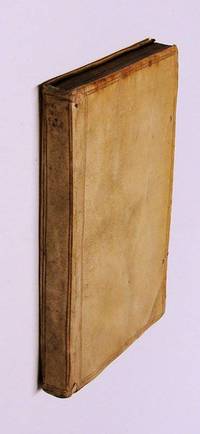
|
|
|
PERIZONIUS J.
Jacobi Perizonii Ant. Fil. Orationes XII varii et praestantioris argumenti in gratiam cultorum elegantiorum litterarum collectae
Leiden Lugdini Batavorum Apud Joh. Arnold Langerak 1740. 8vo. XXXVIII592 p. Vellum 17 cm Details: 5 thongs laced through the joints. Engraved printer's mark on the title it depicts a man who is busy climing a steep hill; a winged diety Father Time Tempus who sways his scythe and has an hourglass on his head helps him to ascend; at the top of the hill rests a huge cornucopia; this scene is flanked Athena and the Muse Clio whose head is winged and who has scroll and quill at hand; the motto reads: 'Dum audes ardua vinces' 'You will be succesful daring' Condition: Vellum age-toned. Both pastedowns slightly stained. Small paper label on the back Note: The Dutch ancient historian Jacobus Perizonius 1651-1715 was professor of History at the University of Franeker from 1682 and from 1693 of Leiden. His historical work broke new ground and may be said to have laid the foundations of historical criticism. It anticipates Niebuhr's method of dealing with the early history of Rome. He made his name with his 'Animadversiones historicae' 1685 which work is recognised as a masterpiece of historical criticism. 'In his 'Origines Babylonicae et Aegypticae 1711 he was the first to suggest the spuriousness of the royal list of Manetho and he defended the chronology of Scaliger'. J.E. Sandys 'A history of classical scholarship' New York 1964 volume 2 p. 331 Perizonius wrote also a learned dissertation on Dictys 1702. His merit as a philologist is demonstrated in his commentary on the 'Minerva' of Sanctius which became a standard 1687 1693 1702 1704 1714 1733 1752 1754 1789 1793 1795 & 1809 and his edition of the 'Variae Historiae' a miscellany of the late antique author Aelianus 1701. � From the dedication at the beginning of this book dated Zaltbommel 1739 we learn that F.G. Westerhovius is the editor of this collection of speeches of Jacob Perizonius 'praeceptoris quondam mei amantissimi'. Westerhovius studied probably under Perizonius at the University of Leiden where Perizonius lectured from 1693. Frederik Wilhelm Westerhovius was born in 1675 and was appointed rector of the Schola Latina at Gorichem and later still alive in 1742 Zaltbommel. Westerhovius added after the 'dedicatio' a 7 page biographical sketch Viri Clarissimi Jacobi Perizonii vita of his admired professor and a list of 12 pages Codices quos Bibliothecae legavit Clarissimus Jacobus Perizonius listing the 38 manuscripts among which one of the 10th century and 59 valuable postincunabula Perizonius bequaethed to the Library of the University of Leiden. The collection of orations opens with Perizonius's inaugural lecture held at Franeker 'De Ciceronis industria' 1682 and his inaugural lecture of Leiden 'De usu Graecae Romanaeque linguae' 1693. Follow 'De Pyrrhonismo historico' 'De doctrinae studiis nuper cultis' 'De origine et natura Imperii' 'De bello contra Gallos et Hispanos' 'De Aethere Britannis & Batavis militante' 'De facta nuper pace' 'Cum Vilhelmus & Maria coronarentur' 'Funebris Mariae Reginae' 'In obitum Abrahami Gravii' Provenance: From the library of Caspar Reuvens and with his library ticket on the spine. Caspar Jacob Christiaan Reuvens 1793-1835 was a Dutch historian and archaeologist. He was the founding director of the Rijksmuseum van Oudheden Dutch National Museum of Antiquities in Leiden the world's first ever professor of archaeology at Leiden University and conducted the first excavations at the Roman provincial site Forum Hadriani in the Netherlands'. See English Wikipedia with his portrait On the verso of the front flyleaf has been attached a small leaflet format visiting card with the text: 'Jacob Perizonius wenscht mijn geachte Buurman in de Veenlaan te 's Gravenhage een gelukzalig jaar van 1867'. On the backside of this: 'Dr. Wap en echtgenoot 1 januari 1867 met een boekgeschenk'. Perizonius is here used as the messenger of the New Year's wishes of Doctor Johannes Jacobus Franciscus Wap to one of his neighbours. The Dutchman Jan Wap 1806-1880 was in the 19th century a wellknown man of letters. The city of The Hague honoured him by naming a street after him the Jan Wapstraat. Wap was living at the time at the Veenkade number 14. The Veenkade nowadays Toussaintkade a row of houses for well to do citizens was part of the canal system singel which went round the city untill the end of the 19th century Collation: -28 34 minus leaf 34 A-2O8 leaf L5 signed M5; leaf 2H6 signed 2H5 Photographs on request hardcover
Referência livreiro : 120119
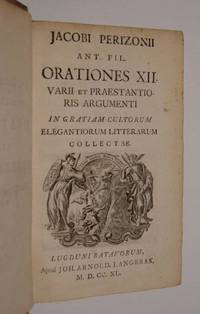
|
|
|
HOMERUS.
Homeri Odyssea. Cum interpretatione lat. ad verbum post alias omnes editiones repurgata plurimis erroribus & quidem crassis alicubi partim ab Henr. Stephano partim ab aliis. Adjecti sunt etiam Homerici Centones qui Graece HOM�POKENTPA: item proverbialium Homeri versuum libellus. Editio postrema diligenter recognita per I.T.P.
Amsterdam Amstelredami Sumptibus Henrici Laurent Bibliopolae 1648. 8vo. 80316741 index p. Contemporary overlapping vellum 16 cm Ref: Schweiger 1158; Hoffmann 2318; Graesse 3328; Ebert 9968; cf Dibdin 251/52 for the Stephanus edition on 1588; Brunet 3272 Details: 5 thongs laced through the joints. Woodcut printer's mark on the title depicting a gardener who is removing with his pruning knife dead bad and otherwise harmful wood. The motto is: 'Non odit tamen' 'Even so he does not hate the tree'. Greek text with facing Latin translation. At the end before the index 67 pages filled with 'Homeric centones' Condition: Vellum age-tanned. Edges of both pastedowns worn. A small and faint waterstain at the right upper corner of the last third of the leaves. Paper slightly yellowing Note: This is part two only the Odyssey part of a two volume set of the 'Homeri Opera cum interpretatione latina' . Editio postrema diligenter recognita per' one 'I.T.P.' published by Laurentius in 1648. This 1648 edition is a reissue of a Parisian edition of 1622/24: 'Homeri poemata duo Ilias et Odyssea sive Ulyssea. Alia item carmina eiusdem . Cum interpretatione lat. Accedunt Homerici centones et proverbialium Homeri versuum libellus. Editio postrema diligenter recognita par I.T.P.'. Who this I.T.P. or J.T.P. was no bibliographer has found out so far. What his editorial contribution was no one knows and has not yet been investigated. He is possibly a Frenchman. All bibliographers agree that this Parisian edition was a repetition of still an earlier 2 volume edition which came from the presses of the famous French scholar and printer Henricus Stephanus the Second in 1588: 'Homeri Ilias et Odyssea alia item carmina eiusdem cum interpretatione latina repurgata plurimis erroribus partim ab Henrico Stephano. Adiecti Homeric centones item proverbialium versuum libellus'. The Latin translation of Homer was made by the Cretan Greek scholar Franciscus Portus 1511-1581. He taught Greek at Ferrara and had to leave for Geneva in 1559 owing to his sympathy with the cause of Reformation. Dibdin notes that his translation was 'not remarkable for its accuracy'. For the good things in the Greek text the credits were given to Henry Estienne or in Latin Henricus Stephanus 1531-1598. 'He will always be numbered among the principal editors of Homer' Dibdin concludes. For the weaknesses in the text it is explained that the great scholar was at the time absent from the office/printshop and that part of it was printed without his superintendence. The Stephanus text of Homer became a kind of standard text in the Netherlands and in Britain. There was another 2 volume reissue published in Amsterdam by Ravestein 1650. This 1648 Odyssey edition on offer further contains the 'Batrachomyomachia' and the 'Homeric hymns' but also the so-called 'Homeric centones' a work composed in late antiquity. These centones derived from the Greek 'kentron' 'needle' form 'patchwork poetry' and consist of complete or half Homeric hexameters. Knit together they create a new narrative of the Bible especially the Gospels in the august epic style of the ancients. They were first printed in 1504 by Aldus. The genre flourished in late antiquity and there was a revival during the Renaissance Provenance: A small coat of arms measuring 1.5 cm has been blind stamped in the front flylaef it consists of a shield divided into 4 fields; in the right upper and left lower field there is a standing cross in the left upper field what seem 2 crossed swords right lower field seems empty. Upon the shield rests a crown with seven points Collation: A-3L8 Photographs on request hardcover
Referência livreiro : 120082
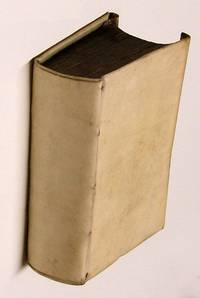
|
|
|
CLAUDIANUS.
Opera Claudiani quat. extant e Claverii Dempsteri & Barthii praecipue scriptis maximam vero partem notis Danielis Hartnacci illustrata.
L�beck Lubacae Impensis Johannis Wiedemeyeri 1701. 12mo. XX598 p. Half vellum 13.5 cm Ref: Schweiger 2284 Details: Title printed in red and black Condition: Binding shabby. Paper on the boards chafed and damaged. Front flyleaf gone. Front inner hinge broken. Small wormhole in the lower corner of the flyleaf and pastedown in the rear. Paper browning Note: Claudius Claudianus ca. 400 was the last important Roman poet. He 'war ein sehr fruchtbarer temperamentvoller Dichter und bietet reichen historischen Stoff in rhetorischem Stil' Buchwald Tusculum-Lexikon 3rd ed. p. 171/2. As 'tribunus et notarius' he acted as court poet for the emperor Theodosius his general Stilicho and the emperor's sons Honorius and Arcadius. In 400 he was honoured with a bronze statue on the Forum Trajanum in Rome. His work was widely read in the Middle Ages. The humanists also placed him on the center stage. In the beginning of the 20th century philologist lost interest but since the rise of interest in late antiquity in the sixties he is again recognized as one of the great Roman poets. NP. s.v. Claudianus. Previous important editions were published in 1602 in Paris by the Frenchman �tienne Clavi�re or in Latin Claverius born ca. 1550. The German scholar Caspar von Barth or Barthius 1587-1658 published in In his youth in 1612 his first edition of Claudian. He republished it with many corrections and additions in 1650. The commentary is says Schweiger '�berladen'. The Scottish scholar Thomas Dempster 1570-1625 published his Claudianus edition in 1607. Daniel Hartnack or Hartnaccius 1642-1708 was a school rector in Bremen Altona and Schleswig. He was known for his numerous polemics many dismissals and quarrels. This man who published the text of such a subtle and elegant poet seems to have been a violent bully. He was e.g. fired in Schleswig for having broken a rib of one of his pupils. This 1701 edition is a reissue it was earlier published in 1691 in L�beck by Otto & Wiedemeyer. C.G. J�cher 'Allgemeines Gelehrten-Lexicon' Leipzig 1750 volume 2 columns 1384/85. Several portraits of Daniel Hartnack or Hartnaccius can be found on the site portraitindex.de Provenance: In old ink on the back: 'Ex libris Josephi Schmidii' Collation: a10 A-2B12 leaf 2B12 blank Photographs on request hardcover
Referência livreiro : 120052

|
|
|
HEINSIUS D.
Danielis Heinsii Orationum editio nova. Tertia parte auctior caeteris sic recensitis ut alia videri possit.
Leiden Lugduni Batavorum Ex officina Bonaventurae & Abrahami Elzevir Acad. Typogr.1627. 8vo. XVI6613 p. Overlapping vellum 15.5 cm � Oratorical fireworks Ref: Willems 277; Berghman 770; Rahir 239 or 240 Details: 5 thongs laced through the joints. Boards with blind double fillet borders. Elsevier's woodcut printer's mark on the title of both volumes depicting an old man standing in the shade of a vine-entwined elmtree symbolising the symbiotic relationship between scholar and publisher. The motto is: 'Non solus' probably indicating the interdependency of publisher and scholar. They cannot do it alone and need each other Condition: Vellum age-tanned. Waterstained in the lower margin at the beginning and at the end of the book. All 4 ties gone. Paper yellowing some faint browning. Old ownership entry on the front pastedown Note: The Dutch classical scholar of Flemish origin Daniel Heinsius 1580-1655 who enjoyed an international reputation as an editor of classical texts theorist of literary criticism historian and neolatin poet was professor of Poetics at the University of Leiden since 1603 extraordinarius Greek since 1605. After the death of J.J. Scaliger to whose inner circle he belonged he held the chair of Greek from 1609 till 1647. His activities have been obscured to later generations by the very bulk and variety of his activities. He is still remembered for his neolatin poetry and for his edition of Aristotle's treatise on poetry 1611 which he studied in connexion with the 'Ars Poetica' of Horace. This edition is 'the only considerable contribution to the criticism and eludication of the work that was ever produced in the Netherlands. . In his pamphlet 'De tragoediae Constitutione' published in the same year 1611 he deals with all the essential points in Aristotle's treatise giving proof that he has thoroughly imbibed the author's spirit'. J.E. Sandys 'A history of classical scholarship N.Y. 1964 vol. 2 p. 314 Heinsius was an inspiring teacher and a talented speaker. 'His courses in the University were so impressive that his colleagues attended his lectures . As an ornament in which the University took especial pride his eloquence graced many public functions. Heinsius composed not only the funeral orations for Philip Cluverius and for Reinerus Bontius Professor of Medicin in 1623 but delivered on 19 September 1625 a 'stupenda oratio' on the death of Prince Maurice for which he received an award of 200 guilders'. Sellin P.R. 'Daniel Heinsius and Stuart England' Leiden etc. 1968 p. 36 The first edition of collected orations 12 of them was published in 1612. The second augmented edition came in 1615. Demand for more orations arose and 1620 saw another augmented edition augmented further in 1627 this edition. This edition naturally opens with this stupendous oration on the death of Prince Maurice followed of course by that other oratorical firework his funeral speech for his beloved master the French scholar Joseph Justus Scaliger a still glowing jewel of the University who died in Leiden in 1609. At the end have been added 27 pages with letters and prefaces that Heinsius wrote for editions of others. Still more augmented editions of the 'Orationes' were published in 1642 1652 and 1657 Provenance: Winterthur provenance On the front pastedown in faint ink: 'And. Bidermanni'. Googling for 'Andr Bidermann' we found a Gymnasium teacher in Winterthur born in 1776 appointed in 1819. There were several hits placing a Andr. Bidermann in the Canton Z�rich Winterthur. More indications in that direction when we searched for 'Andreas Bidermann' Collation: 8 A-2S8 2T4; we couldnot find out whether our copy has the cancels of p. 277/8 and 419/20 which Willems mentions or not Photographs on request hardcover
Referência livreiro : 120074
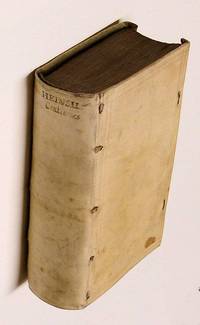
|
|